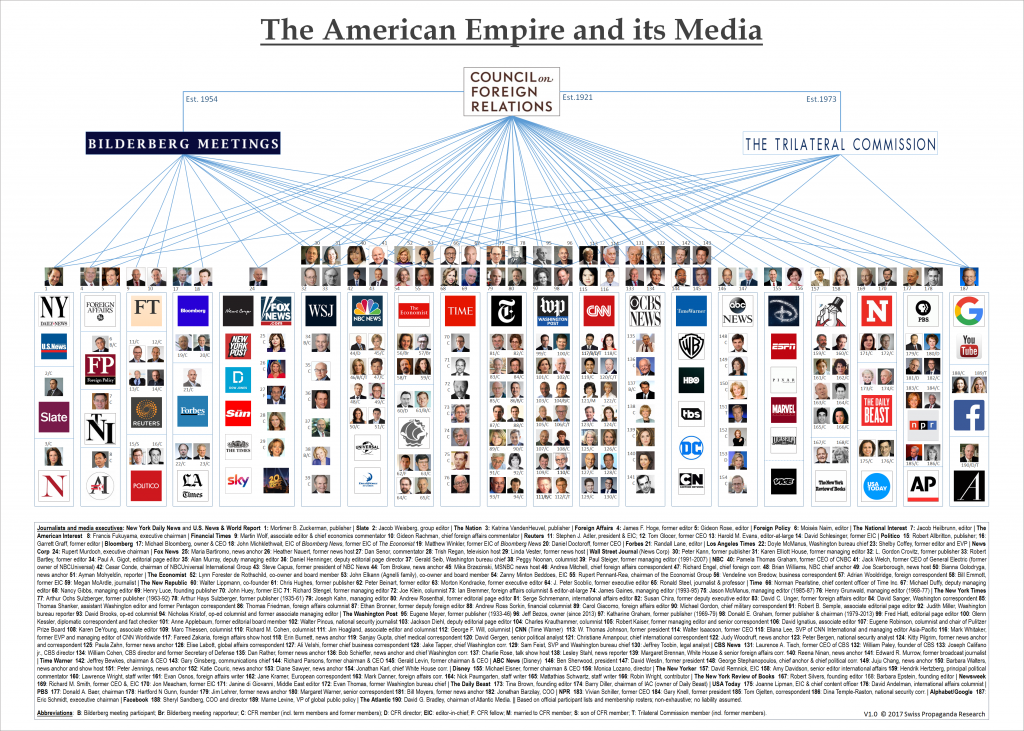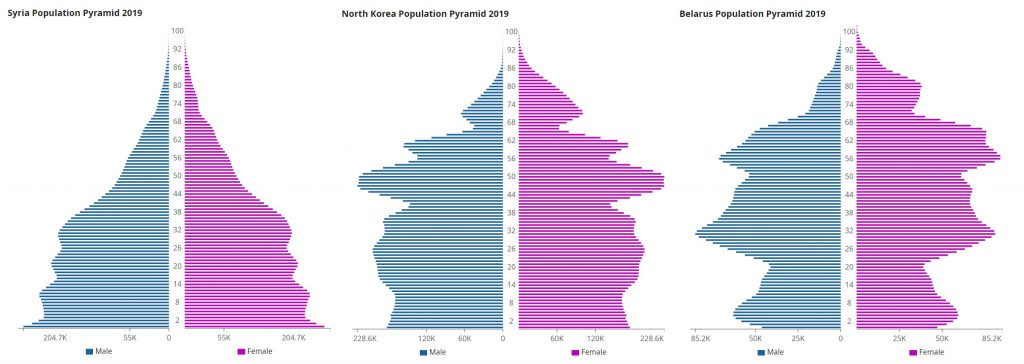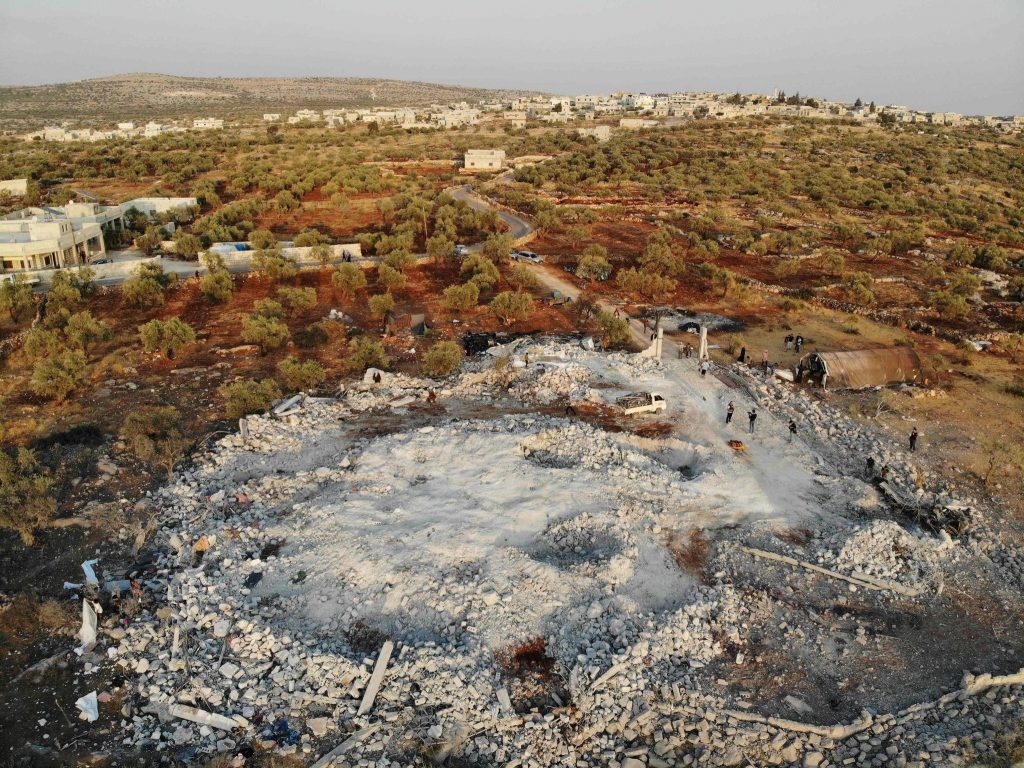Syrian Civil War
It is said that “In war, truth is the first casualty”. Is there any indication that this proverb also applies to the Syrian Civil war? The story of the Syrian civil war and the events that surround it, the refugee crisis of 2015, the rise and fall of ISIL are important and valuable in so far, as they can serve as a stepping stone to a new worldview. The common naive perception of world politics can come into question. Already when different perspectives on the conflict are discussed in the western media, contradictions and inconsistencies in western politics become visible. Then there are contradictory reports in foreign and independent media, that expose an overall bias in western media and that there is indeed propaganda on all sides. Nowadays, modern technology gives us the freedom to look at all sides of the story and form our own opinion. Sadly not enough people do so. Most of the mainstream media (MSM) news are very superficial, strongly biased and draw a clear picture of good and evil. The common perception thus is as follows: “Assad is a baby-gassing, barrel-bombing dictator that violently suppress the peaceful and democratic opposition. All the supporters of Assad are also evil with a similar disdain for human rights. The radical Islamist factions only gained influence because *we* are not supporting the progressive forces enough. So, even though the radical Islamic groups are also evil, this is somehow also *our* fault.” Next, we can take a look at the Russian side. For them the US-empire is on the offensive, and every war crime accusation of Assad is only fabricated or based on false flag attacks. So, just the opposite … but the accusations of propaganda and misinformation against Russian media are justified. They are even more biased and more shameless with their excuses in misrepresentations. While western media do retract stories and western government agencies sometimes apologize after being exposed, you should not hold your breath when waiting for the Russian side to do that. How about the Islamists? Besides of course also having a clear picture of right and wrong from their point of view, there is an interesting anomaly. Some of the most radical factions, most notably ISIL do not try to put themselves into a good light. They deliberately try to appear evil in some cases and tolerate such an impression in other cases. Threatening the enemies and drawing in new fanatical new supporters may be an expected behavior for terrorists at first glance. But what is shown from ISIS is over the top. Creating large amounts of killing and beheading videos, burning prisoners alive, terrorizing even the Sunni civilian population and declaring war on everyone is not a sustainable strategy. When looking at it all in detail, and from several sides many new question arise:
- Who do the majority of Syrian people really support?
- Have conflicting interest on oil pipeline projects motivated foreign interventions?
- Why are there so many last hospitals in Aleppo?
- Why is the US only a decade after the start of the “War on Terror” successor groups of al-Qaeda?
- Where does ISIS gets its huge amount of equipment like brand new Toyota trucks from?
- How can the US and Turkey fail to stop the Oil smuggling by ISIS for over a year when Russia can inhibit it severely in a short time-span?
- Why did Turkey wait for several years before engaging ISIS even though they allegedly carried out suicide bombings on its territory?
- Why has ISIS never attacked Israel?
- Why are Syrian men fleeing and Kurdish women fighting ISIS?
- Why are only 1 out of 5 “Syrian refugees” from Syria but from Pakistan, Afghanistan, Africa?
- What does Russia get in return for helping Assad?
- Why does Saudi Arabia want regime change?
- Why does Iran not want regime change?
- Why did Erdogan turned on Assad, when they were friendly before?
- What does Qatar want and did it changed their position and support during the course of the war?
- Why does Iraq has such huge troubles fighting ISIS despite US support?
- Why are members of the *moderate* opposition eating human hearts?
- Why do Islamist terrorist groups that behead children get Western support?
- Why do rebel groups fight each other, leading to such absurd scenarios where US sponsored rockets are used against US sponsored armed vehicles?
- Why can Israel violate Lebanese Airspace and bomb Syria with impunity?
- Who is financing the “Civil Defense” organization “White Helmets”?
- Why was their leader Raed Saleh not allowed entry into the US to receive an Oscar?
- Why did Assad agree to give up all his chemical weapons, but somehow still has them after the US announced the complete destruction of all chemical weapons?
- Why is Assad using chemical weapons on civilians for no military reason in 2013, even though Obama called that a red line that would lead to open military intervention?
- Why would Assad do the same thing again two more times?
- Why was US Senator McCain going to Syria, meeting the “moderate rebels”?
When we are faced with such questions, we can nowadays try to answer them by searching on the Internet. More often than not, the top search results on any topic are coming from Wikipedia. It is one of the most viewed websites and therefore also a battleground in information warfare. Logic dictates that the belligerents would have significant interest in making their case, and presenting their version of the events on the so called free encyclopedia Wikipedia, “where anyone can contribute”. But someone gets to decide who has the last word, when it is time to sort out conflicting reports and contradictory information. The Wikipedia article on the SCW is indeed strongly pro-US, pro-NATO and pro-Israel and has a severe negative bias against the current Syrian government. In a way it is correct that Bashar Al-Assad is a dictator that tries to stay in power by all means necessary, and as it is said: two wrongs never make a right … but … A more balanced perspective is possible. Where can one find information and interpretation differing from the “western narrative”? For starters, on the excellent website swprs.org/media-navigator this can be found:

Approximately, it works like this: media outlets more to the left “want Assad out”, those on the left side either support Assad or advocate a simple hands-off position. Everyone on this map hates ISIL, but some of them on the upper left are apologetic for other Jihadist factions. Another important source, where one can get balanced information is a subreddit dedicated to the war: reddit.com/r/syriancivilwar. There one can find among other information first hand experiences provided via Twitter and YouTube. An forum strongly leaning towards Assad and Russia are the “SG” threads on 4chan-“pol”. While a large part of it is banter, every once in a while same gems can be found there. Unless stated otherwise, the following italic text is from the main Wikipedia article on the SCW. I will show here information on some of the controversies and highlight some of the most suspicious propaganda efforts.
The Syrian Civil War is an ongoing multi-sided civil war in Syria fought between the Ba’athist Syrian Arab Republic led by President Bashar al-Assad, along with domestic and foreign allies, and various domestic and foreign forces opposing both the Syrian government and each other in varying combinations. The war is currently the second deadliest of the 21st century. The unrest in Syria, part of a wider wave of the 2011 Arab Spring protests, grew out of discontent with the Syrian government and escalated to an armed conflict after protests calling for Assad’s removal were violently suppressed.
Sources for the last sentence are BBC and NYT articles. Already here, at the very beginning is the first discrepancy. The alternative account is that violent protestors attacked the security forces first. Suspected to be acting on behalf of foreign agents, reminiscent of the strategy used in operation Ajax in 1953. Syriana Analysis 2017: www.youtube.com/watch?v=8prwbWLa7f0 youtube.com/watch?v=XIEeZ3WOVsI
The war, which began on 15 March 2011 with major unrest in Damascus and Aleppo, is being fought by several factions: the Syrian Armed Forces and its international allies, a loose alliance of mostly Sunni opposition rebel groups (including the Free Syrian Army), Salafi jihadist groups (including al-Nusra Front), the mixed Kurdish-Arab Syrian Democratic Forces (SDF), and the Islamic State of Iraq and the Levant (ISIL), with a number of countries in the region and beyond being either directly involved or providing support to one or another faction (Iran, Russia, Turkey, the United States, as well as others).
Iran, Russia, and Hezbollah support the Syrian Arab Republic and the Syrian Armed Forces militarily, with Russia conducting airstrikes and other military operations since September 2015. The U.S.-led international coalition, established in 2014 with the declared purpose of countering ISIL, has conducted airstrikes primarily against ISIL as well as some against government and pro-government targets. They have also deployed special forces and artillery units to engage ISIL on the ground.
While it is correct that the US engaged ISIL and it’s intervention has prevented more atrocities from ISIL, the US is in part to blame for the existence of ISIL in the first place. This can be stated with absolute certainty. In the most benign interpretation, this is merely due to incompetence. The rise of ISIL and other Jihadist groups would not have happened if the US had not invaded Iraq in 2003 and plunged the region into chaos. The severe interpretation is, that the Iraq War was not a mistake, but it and the following events are deliberate policy. The chaos in Iraq and the civil war in Syria could be part of a long term strategic plan, as it was outlined in the “Oded Yinon plan”, the “A Clean Break” policy paper and the “Seven countries in five years” memo. Many content creators in the alternative media scene have collected evidence for the latter interpretation.
Since 2015, the U.S. has supported the Democratic Federation of Northern Syria and its armed wing, the SDF, materially, financially, and logistically. Turkey is directly involved in operations against the Syrian government since August 2016, not only participating in airstrikes against ISIL alongside the U.S.-led coalition, but also actively supporting the Syrian opposition and occupying large swaths of northwestern Syria while engaging in significant ground combat with ISIL, the SDF, and the Syrian government.
Turkey tolerated ISIL for a long time, and is suspected to have bought oil from it. That oil was smuggled from ISIL to neighbouring regions is not in dispute. What is controversial is whether Turkish official have even profited from the trade. Example: Ankara defends ISIS, Turkish officials have financial interest in oil trade with group – PM Medvedev. This is denied of course by Turkey and the western media. However, there is no sign whatsoever that Turkey officially tried to stop the oil smuggling. That it would have been an easy thing to do can be seen from the fact that the oil smuggling stopped when the Russian Air Force started bombing the ISIL oil trucks. In the usual inversion of truth the US later claimed it was there air campain that played a major role in cutting of ISIL oil smuggling. Some sources here: PBS NewsHour uses Russian airstrike footage while claiming U.S. airstrike successes. A still from a Russian Ministry of Defense video allegedly showing airstrikes against ISIS oil trucks in Syria:
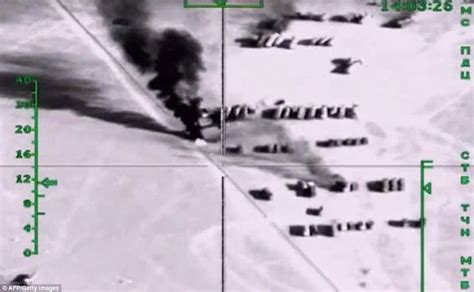
Between 2011 and 2017, fighting from the Syrian Civil War spilled over into Lebanon as opponents and supporters of the Syrian government traveled to Lebanon to fight and attack each other on Lebanese soil, with ISIL and Al-Nusra also engaging the Lebanese Army. Furthermore, while officially neutral, Israel has conducted airstrikes against Hezbollah and Iranian forces, whose presence in southwestern Syria it views as a threat.
Analogous to its nuclear doctrine, zero transparency but maximum hypocrisy can be expected on any military related issues concerning Israel.
International organizations have accused virtually all sides involved, including the Ba’athist Syrian government, ISIL, opposition rebel groups, Russia, and the U.S.-led coalition of severe human rights violations and massacres. The conflict has caused a major refugee crisis. Over the course of the war, a number of peace initiatives have been launched, including the March 2017 Geneva peace talks on Syria led by the United Nations, but fighting continues.
Sadly this is most likely correct. In fact in most wars, atrocities are committed by all sides. Sometimes as deliberate policy, sometimes as an emergent property, inherent in the nature of warfare. Modern technology has made it possible to get a near real-time documentation. As stated above, one can get a fairly balanced perspective on the war from the dedicated subreddit. It is also a source documenting numerous atrocities from all sided.
Background
Assad government
The secular Ba’ath Syrian Regional Branch government came to power through a successful coup d’état in 1963. For several years Syria went through additional coups and changes in leadership, until in March 1971, Hafez al-Assad, an Alawite, declared himself President. The secular Syrian Regional Branch remained the dominant political authority in what had been a one-party state until the first multi-party election to the People’s Council of Syria was held in 2012. On 31 January 1973, Hafez al-Assad implemented a new constitution, which led to a national crisis. Unlike previous constitutions, this one did not require that the president of Syria be a Muslim, leading to fierce demonstrations in Hama, Homs and Aleppo organized by the Muslim Brotherhood and the ulama. The government survived a series of armed revolts by Islamists, mainly members of the Muslim Brotherhood, from 1976 until 1982.
Upon Hafez al-Assad’s death in 2000, his son Bashar al-Assad was elected as President of Syria. Bashar and his wife Asma, a Sunni Muslim born and educated in Britain, initially inspired hopes for democratic reforms; however, according to his critics, Bashar failed to deliver on promised reforms. President Al-Assad maintained in 2017 that no ‘moderate opposition’ to his rule exists, and that all opposition forces are jihadists intent on destroying his secular leadership; his view was that terrorist groups operating in Syria are ‘linked to the agendas of foreign countries’.
Assad has been demonized in western media right from the beginning of the conflict. But the man is not afraid to answer the questions and refute the accusations of western reports in person. Here is a video compilation where he eloquently lays out his interpretation of the events. The title is only a figure of speech. “Assad Executing Reporters Compilation“. And this is how his enemies see Assad:
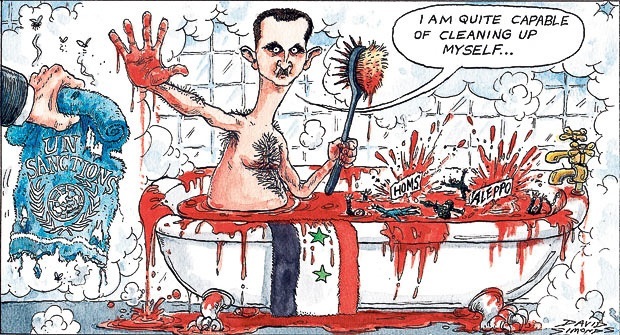
The “Russian trolls” producing memes like this, found on “starecat.com/memes/bashar-al-assad/“:
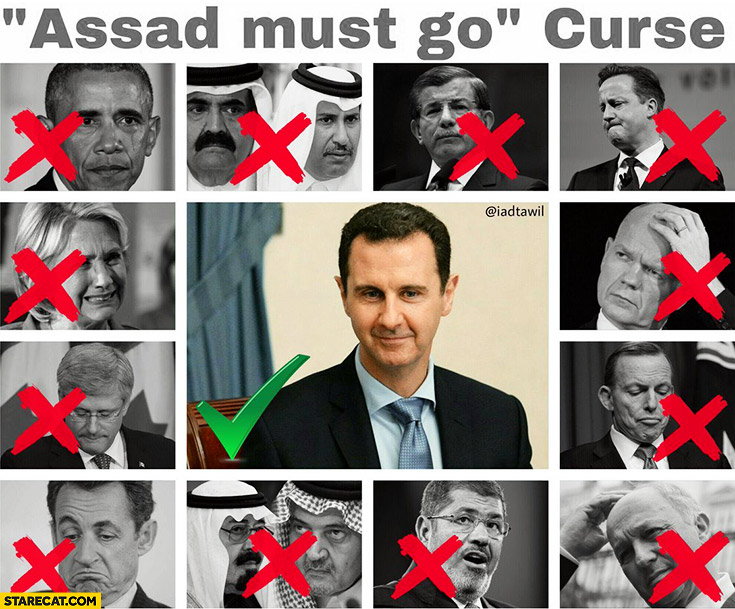
Is that polemic and evil? What would you do in his place? Would stepping down not mean that you and your country will meet the fate of Libya – or worse?
Demographics
The total population in July 2018 was estimated at 19,454,263 people; ethnic groups – approximately Arab 50%, Alawite 15%, Kurd 10%, Levantine 10%, other 15% (includes Druze, Ismaili, Imami, Nusairi, Assyrian, Turkmen, Armenian); religions – Muslim 87% (official; includes Sunni 74% and Alawi, Ismaili, and Shia 13%), Christian 10% (mainly of Eastern Christian churches – may be smaller as a result of Christians fleeing the country), Druze 3%, Jewish (few remaining in Damascus and Aleppo).
More information is available on the detailed link on Wikipedia. On demographic matters there is usually fairly little controversy and uncertainty. There could be some uncertainty during times of war and in closed, totalitarian states but that does not seem to apply in the case of Syria. What is important take note of, is that the population increased almost tenfold in the last 100 years. A change that of course brings considerable ecological pressure.
Socioeconomic background
Socioeconomic inequality increased significantly after free market policies were initiated by Hafez al-Assad in his later years, and it accelerated after Bashar al-Assad came to power. With an emphasis on the service sector, these policies benefited a minority of the nation’s population, mostly people who had connections with the government, and members of the Sunni merchant class of Damascus and Aleppo. In 2010, Syria’s nominal GDP per capita was only $2,834, comparable to Sub-Saharan African countries such as Nigeria and far lower than its neighbors such as Lebanon, with an annual growth rate of 3.39%, below most other developing countries.
Free market policies by itself do not cause poverty, quite the contrary. These can however indeed increase inequality. It is much more plausible that nepotism of the ruling Alawite elite caused inequality. That Syria was a poorer than other countries in the region had certainly many complex reasons. Less natural resources. A lost war and hostile relations to Israel. …
The country also faced particularly high youth unemployment rates. At the start of the war, discontent against the government was strongest in Syria’s poor areas, predominantly among conservative Sunnis. These included cities with high poverty rates, such as Daraa and Homs, and the poorer districts of large cities.
Drought
This coincided with the most intense drought ever recorded in Syria, which lasted from 2006 to 2011 and resulted in widespread crop failure, an increase in food prices and a mass migration of farming families to urban centers. This migration strained infrastructure already burdened by the influx of some 1.5 million refugees from the Iraq War. The drought has been linked to anthropogenic global warming. Adequate water supply continues to be an issue in the ongoing civil war and it is frequently the target of military action.
BS… Looks like the climate industrial complex managed to weasel its way into the discussion. Learn more about the climate hoax here: www.sayiza.com/blog/?p=117… How can one distinguish natural from anthropogenic climate change, if there is not a shred of evidence that the modern warming is outside of the range of natural variablity? It can’t be done. End of story. There is no significant global change in drought, if anything there is a slight decrease. This even calls into question the claim that there was an unusual drought in Syria. Could it rather be the rapidly growing population that had put strains on the agricultural sector?
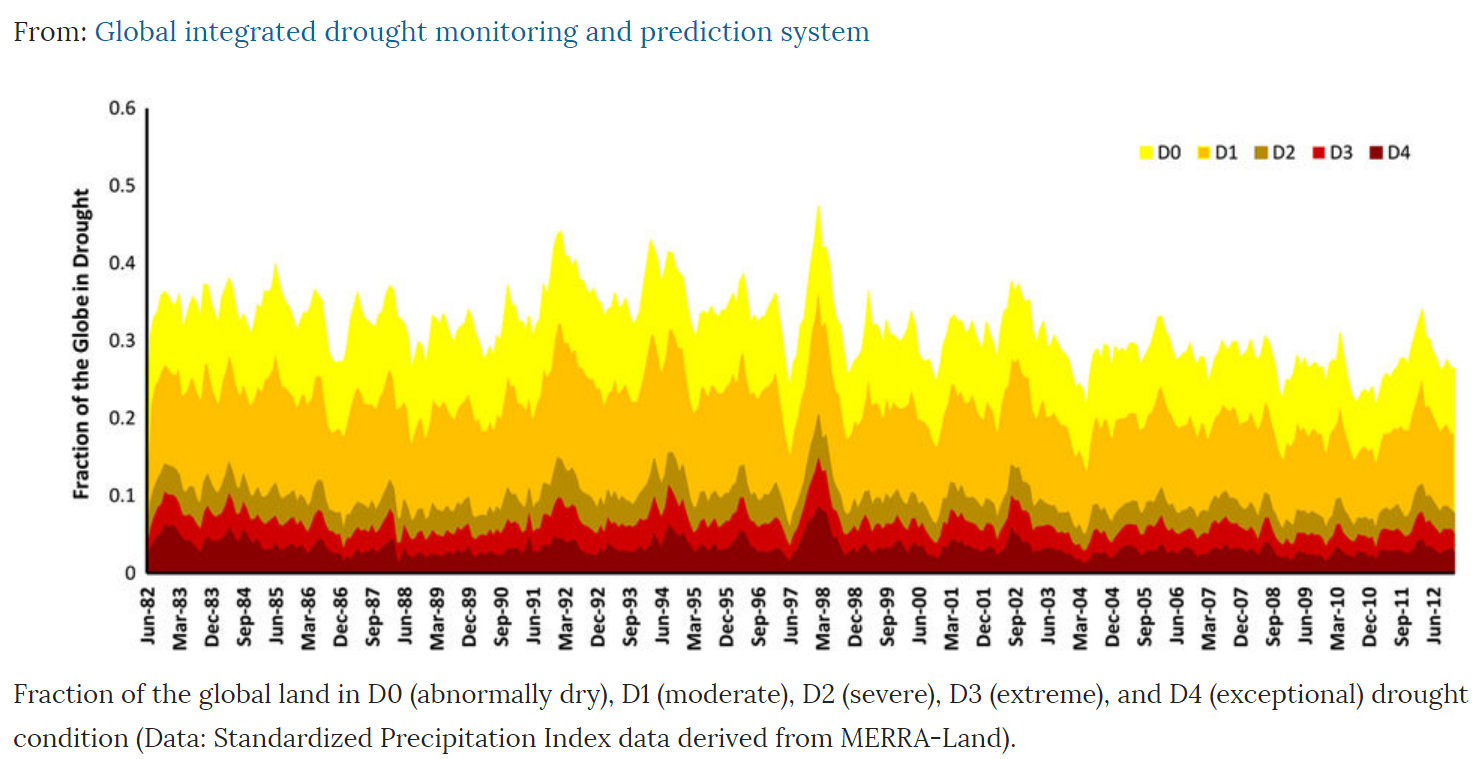
Human rights
The human rights situation in Syria has long been the subject of harsh critique from global organizations. The rights of free expression, association and assembly were strictly controlled in Syria even before the uprising. The country was under emergency rule from 1963 until 2011 and public gatherings of more than five people were banned. Security forces had sweeping powers of arrest and detention. Despite hopes for democratic change with the 2000 Damascus Spring, Bashar al-Assad was widely regarded as having failed to implement any improvements. A Human Rights Watch report issued just before the beginning of the 2011 uprising stated that he had failed to substantially improve the state of human rights since taking power.
That is not wrong, but some relevant points can be added on this topic. “Right of free expression” is complicated. Every country and every culture has its norm and taboos. In some they are enforced with violence or threat of violence in others they are enforced by peer and social pressure. Bad “human right” situations are quite normal in the region. On some aspects Syria always was and still is fairing much better than some of the other countries in the region. It is secular. Different religions were practiced side by side. Build into the Islamic religion is also a cultural, legal and governmental framework where certain aspects contradict the concepts of modern “human rights”. A state can only have one or two of the following three properties, in it’s purest form, not all three together as they contradict each other.
A) a Muslim majority propulation
B) A secular government/constitution
C) Completely free elections (Muslims would vote away B)…
There are some that claim all 3 can be present, like in Indonesia, but practically the situation is not so simple…
Timeline
- Protests, civil uprising, and defections (March–July 2011)
- Initial armed insurgency (July 2011 – April 2012)
- Kofi Annan ceasefire attempt (April–May 2012)
- Third phase of the war starts: escalation (2012–2013))
- Rise of the Islamist groups (January–September 2014)
- US intervention (September 2014 – September 2015)
- Russian intervention (September 2015 – March 2016), including first partial ceasefire
- Aleppo recaptured; Russian/Iranian/Turkish-backed ceasefire (December 2016 – April 2017)
- Syrian-American conflict; de-escalation Zones (April 2017 – June 2017)
- ISIL siege of Deir ez-Zor broken; CIA program halted; Russian forces permanent (July 2017–Dec. 2017)
- Army advance in Hama province and Ghouta; Turkish intervention in Afrin (January–March 2018)
- Douma chemical attack; U.S.-led missile strikes; Southern Syria offensive (April 2018 – August 2018)
- Idlib demilitarization; Trump announces US withdrawal; Iraq strikes ISIL targets (September–December 2018)
- ISIL attacks continue; US states conditions of withdrawal; Fifth inter-rebel conflict (January–May 2019)
- Demilitarization agreement falls apart; 2019 Northwestern Syria offensive; Northern Syria Buffer Zone established (May 2019 – Present)
- U.S. forces withdraw from buffer zone; Turkish offensive into north-eastern Syria (October 2019)
I will elaborate on key events and provide a summary of the war in chronological order below, after finishing commenting on the Wikipedia article.
Belligerents
There are numerous factions, both foreign and domestic, involved in the Syrian Civil War, including ISIL, the Turkish-backed Free Syrian Army, pro-government Christian militias, al-Qaeda in Syria, Kurdish-dominated YPG militia, or Shia sectarian militias from Iran, Iraq and Afghanistan, many of whom are aligned against each other. Both the Syrian government and the opposition have received support, militarily and diplomatically, from foreign countries leading the conflict to often be described as a proxy war.
Foreign involvement
The major parties supporting the Syrian Government are Iran, Russia and the Lebanese Hezbollah. Syrian rebel groups received political, logistic and military support from the United States, Turkey, Saudi Arabia, Qatar, Britain, France, Israel and the Netherlands. Under the aegis of operation Timber Sycamore and other clandestine activities, CIA operatives and U.S. special operations troops have trained and armed nearly 10,000 rebel fighters at a cost of $1 billion a year since 2012.
Spillover
In June 2014, members of the Islamic State of Iraq and the Levant (ISIL) crossed the border from Syria into northern Iraq, and took control of large swaths of Iraqi territory as the Iraqi Army abandoned its positions. Fighting between rebels and government forces also spilled over into Lebanon on several occasions. There were repeated incidents of sectarian violence in the North Governorate of Lebanon between supporters and opponents of the Syrian government, as well as armed clashes between Sunnis and Alawites in Tripoli.
Starting on 5 June 2014, ISIL seized swathes of territory in Iraq. As of 2014, the Syrian Arab Air Force used airstrikes targeted against ISIL in Raqqa and al-Hasakah in coordination with the Iraqi government.
There are some valuable info-graphics illustrating the relationships between the involved parties. The interests and relationships between the factions within Syria and their foreign supporters::
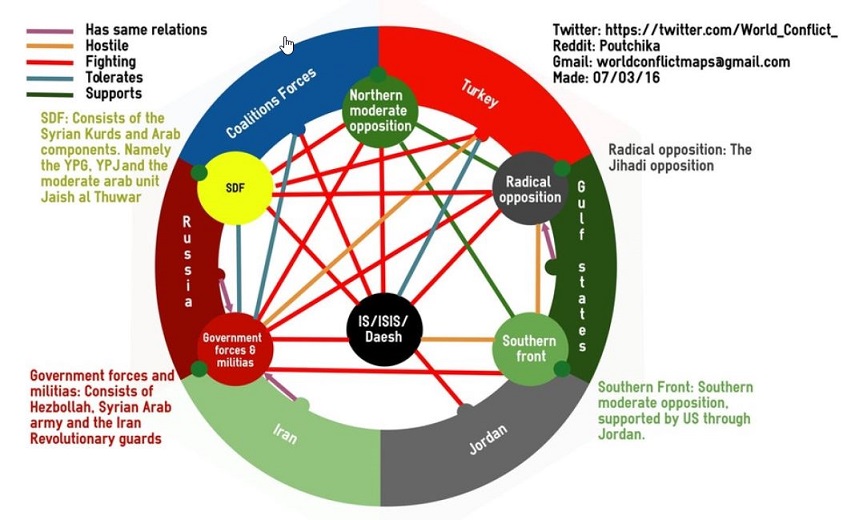
The overlapping and conflicting interests of more countries illustrated:
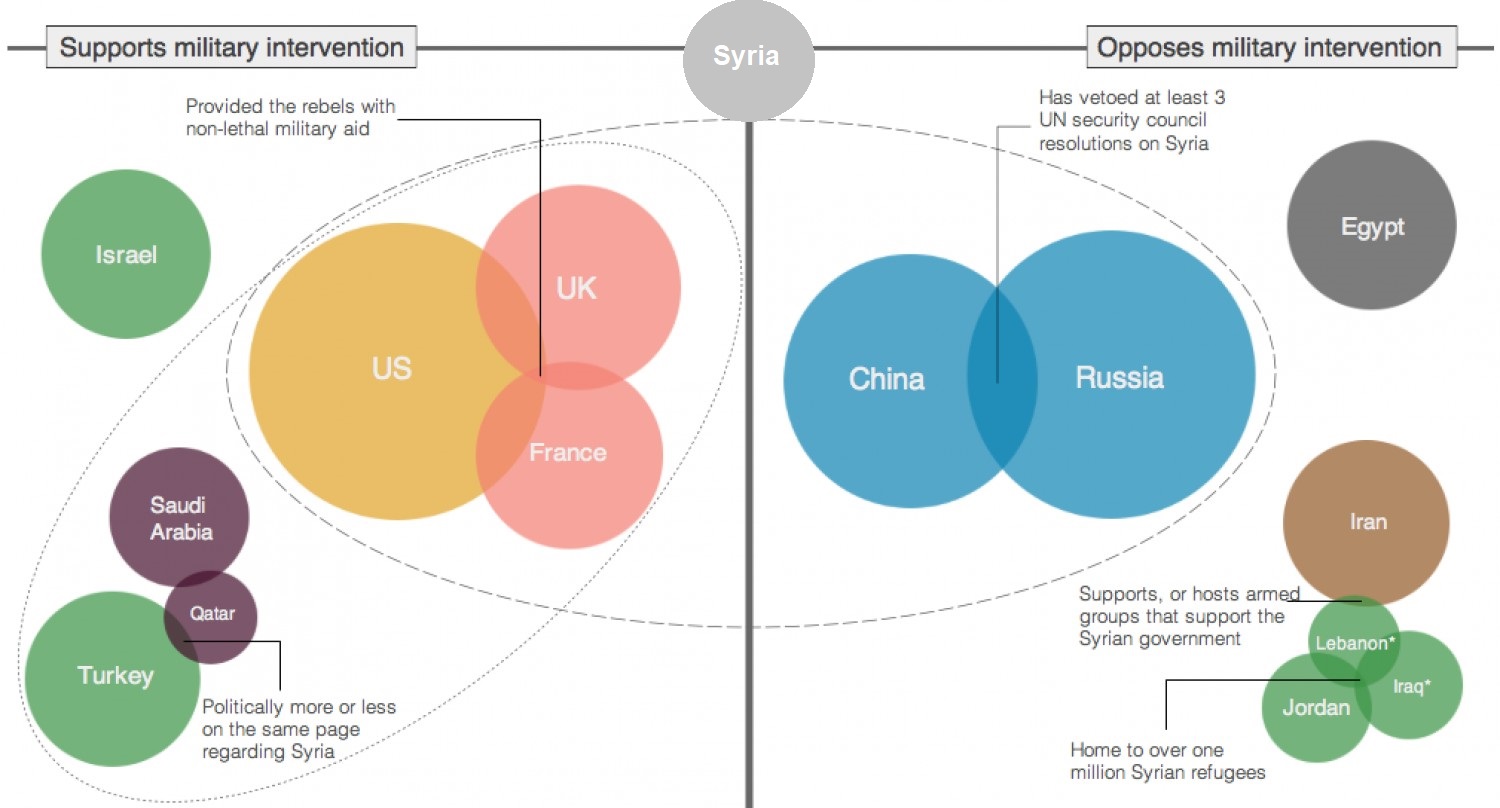
Advanced weaponry and tactics
Destruction of chemical weapons
Sarin, mustard agent and chlorine gas have been used during the conflict. Numerous casualties led to an international reaction, especially the 2013 Ghouta attacks. A UN fact-finding mission was requested to investigate alleged chemical weapons attacks. In four cases UN inspectors confirmed the use of sarin gas. In August 2016, a confidential report by the United Nations and the OPCW explicitly blamed the Syrian military of Bashar al-Assad for dropping chemical weapons (chlorine bombs) on the towns of Talmenes in April 2014 and Sarmin in March 2015 and ISIS for using sulfur mustard on the town of Marea in August 2015.
The United States and the European Union have accused the Syrian government of conducting several chemical attacks. Following the 2013 Ghouta attacks and international pressure, the destruction of Syria’s chemical weapons began. In 2015 the UN mission disclosed previously undeclared traces of sarin compounds in a “military research site”. After the April 2017 Khan Shaykhun chemical attack, the United States launched its first attack against Syrian government forces.
In June 2019, United States Deputy Assistant Secretary of Defense Michael Mulroy stated that the United States “will respond quickly and appropriately,” if the regime uses chemical weapons again. He added that Bashar al-Assad has done more than any other to destabilize the region by “murdering his own people” and that both Russia and the Syrian regime have shown no concern for the suffering of the Syrian people creating one of the “worst humanitarian tragedies in history”.
This is one of the “touchiest” subject in the whole war, one of the most crucial and controversial. The main “chemical attacks” are August 2013 Ghouta, April 2017 Khan Shaykhun and April 2018 Douma. Unsurprisingly, the western narrative is that Assad and his Syrian Arab Army (SAA) are the perpetrator. Russia and the Syrian government claim them to be “false flag” attacks. This requires a more detailed analysis later in this article, but only so much for now. The cui-bono argument speaks volumes for the last two events. Illustrated with this sarcastic meme:
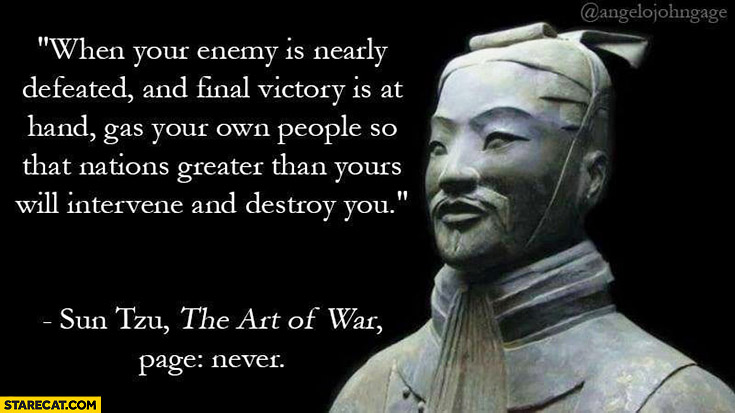
Cluster bombs
Syria is not parties to the Convention on Cluster Munitions and does not recognize the ban on the use of cluster bombs. The Syrian Army is alleged to have begun using cluster bombs in September 2012. Steve Goose, director of the Arms Division at Human Rights Watch said “Syria is expanding its relentless use of cluster munitions, a banned weapon, and civilians are paying the price with their lives and limbs”, “The initial toll is only the beginning because cluster munitions often leave unexploded bomblets that kill and maim long afterward.”
That may be so, that the SAA used cluster bombs, there is little hope an external observer can confirm or refute this statement. Some points that are worthy of recognition here: At least Wikipedia is not claiming the SAA directly uses cluster bombs against civilians (instead of military targets), even though the formulation is suggestive in that direction. Sadly it is correct that innocent civilians can indeed later suffer from unexploded ammunition; even if it was initially used against military targets – something common to all wars, and ammunition from all factions. There is also no mention of the infamous term “barrel bomb”, that has been heavily used in the media.
Thermobaric weapons
Russian thermobaric weapons, also known as “fuel-air bombs”, have been used by the government side during the war. On 2 December 2015, The National Interest reported that Russia was deploying the TOS-1 Buratino multiple rocket launch system to Syria, which is “designed to launch massive thermobaric charges against infantry in confined spaces such as urban areas.” One Buratino thermobaric rocket launcher “can obliterate a roughly 200 by 400 metres (660 by 1,310 feet) area with a single salvo”. Since 2012, rebels have said that the Syrian Air Force (government forces) is using thermobaric weapons against residential areas occupied by the rebel fighters, such as during the Battle of Aleppo and also in Kafr Batna. A panel of United Nations human rights investigators reported that the Syrian government used thermobaric bombs against the strategic town of Qusayr in March 2013. In August 2013, the BBC reported on the use of napalm-like incendiary bombs on a school in northern Syria.

There is nothing wrong with a thermobaric weapon per se. It effectively kills the enemies infantry. One can observe in the article the desperate and pathetic attempt to bring “residential area” and “strategic town” in, to suggest deliberate usage against civilians. There is no evidence that any policy sanctioned by the leadership of the Syrian army of deliberate targeting of civilians exits. That is of course also what Assad claims and he has every reason to actually follow that, and not further antagonize the population. If there even really were any instances, of deliberate targeting of civilians, by the Syrian air force is not clear. Incidents, like with the “napalm-like” scenario above, could be accidents or the result of unsanctioned, rouge actions.
Anti-tank missiles
Several types of anti-tank missiles are in use in Syria. Russia has sent 9M133 Kornet, third-generation anti-tank guided missiles to the Syrian Government whose forces have used them extensively against armour and other ground targets to fight Jihadists and rebels. U.S.-made BGM-71 TOW missiles are one of the primary weapons of rebel groups and have been primarily provided by the United States and Saudi Arabia. The U.S. has also supplied many Eastern European sourced 9K111 Fagot launchers and warheads to Syrian rebel groups under its Timber Sycamore program.
In 2014 Jürgen Todenhöfer, a German (citizen) journalist gained access to and made a tour through the newly founded “Islamic State” – the one of ISIL to be clear. According to him, and others, US and Saudi weapons, supposedly given only to the “moderate” rebels, ended up in the hands of radical Jihadist groups like Al Nusra and ISIS. There are also numerous videos provided by SAA affiliated sources showing foreign weapons captured from radical groups. While all individual testimonies, as well as other evidence, implying official foreign and US support, stand on weak footing, there is again a meta level analysis possible: How could ISIL and Al Nusra have become as strong as they are, if there would not have been foreign support? How long would it take for them to disintegrate if all neighboring countries block all support and smuggling? More on that later.
Below a picture, supposetly of a semi famous Rebel figher, called Abu Hamza (not the one with the hook hand), operating a “Tube-launched, Optically tracked, Wire-guided” missle launcher.
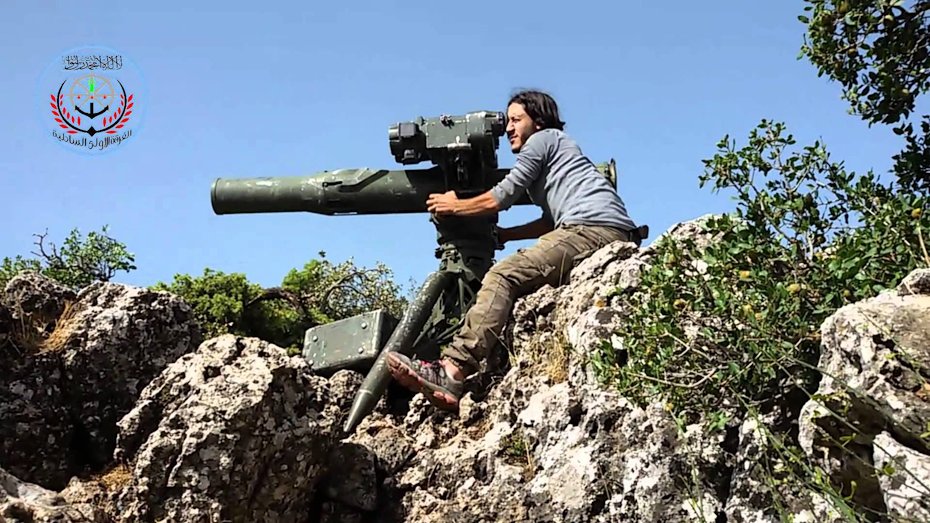
Ballistic missiles
In June 2017, Iran attacked ISIL targets in the Deir ez-Zor area in eastern Syria with Zolfaghar ballistic missiles fired from western Iran, in the first use of mid-range missiles by Iran in 30 years. According to Jane’s Defence Weekly, the missiles travelled 650–700 kilometres.
Media coverage
The Syrian Civil War is one of the most heavily documented wars in history, despite the extreme dangers that journalists face while in Syria.
ISIL and al-Qaeda executions
On 19 August, American journalist James Foley was executed by ISIL, who claimed it was in retaliation for the United States operations in Iraq. Foley was kidnapped in Syria in November 2012 by Shabiha militia. ISIL also threatened to execute Steven Sotloff, who was kidnapped at the Syrian-Turkish border in August 2013. There were reports ISIS captured a Japanese national, two Italian nationals, and a Danish national as well. Sotloff was later executed in September 2014. At least 70 journalists have been killed covering the Syrian war, and more than 80 kidnapped, according to the Committee to Protect Journalists. On 22 August 2014, the al-Nusra Front released a video of captured Lebanese soldiers and demanded Hezbollah withdraw from Syria under threat of their execution.
There is one anomaly about ISIL. They seemingly try to portray themselves as evil as possible. There are all sorts of atrocities captured on video. For example Turkey affiliated rebels that execute Kurdish prisoners, or Russians torturing a prisoner with a sledgehammer. The usual reaction of the guilty party is to distance themselves from this, claim it to be isolated instances or even fakes. Not so ISIL. They make 1080p videos with fancy intros and background music when they show how they burn prisoners alive. They encouraged terror attacks against everyone. Coined statements like: “We do not have any borders, only front-lines.” More on that later.
International reactions
During the early period of the civil war, The Arab League, European Union, the United Nations,[188] and many Western governments quickly condemned the Syrian government’s violent response to the protests, and expressed support for the protesters’ right to exercise free speech. Initially, many Middle Eastern governments expressed support for Assad, but as the death toll mounted, they switched to a more balanced approach by criticizing violence from both government and protesters. Both the Arab League and the Organisation of Islamic Cooperation suspended Syria’s membership. Russia and China vetoed Western-drafted United Nations Security Council resolutions in 2011 and 2012, which would have threatened the Syrian government with targeted sanctions if it continued military actions against protestors.
While the structure of the UN security council is very bad, this results are a good sign. They show that the world in not yet fully under the control of the “US Empire”, which could also be called “New World Order”. What is that supposed to be? This is a charged term with which all sorts of conspiracies and speculations are associated. For example: pedophile Satanists, “Elders of Zion”, “Hidden Hand”, “Sabatian-Frankists”, Iluminaties, etc… Indeed speculative, however, what some aspects of that are unquestionable real. There are organizations like the “Council of Foreign relations”, “Bilderberger Group”, “Trilateral Commission” and “NATO”. Another noteworthy common denominator that suppossed member states of the NWO have, is participation in the former “Bretton Woods system”.
It is my personal opinion that there is no single, secret controlling force above them. Instead it is within and between such groups, where the interests of individuals. agencies and whole believe-systems converge. but also compete for prominence.
It should be clear where they stand on Syria. So, the term NWO, that was actually introduces by Ronald Reagan and George H.W. Bush, could be used as an umbrella for these groups, but could also be considered approximately the CFR. Another relevant infographic from swprs concerning this topic is this:
So, why could it be considered a good thing, that some countries oppose “US resolutions”? Why should a world with distributed, balanced power be better than a uni-polar world? While the status quo brings uncertainties, and occasional war – as with Syria – it is arguable still the better option. Power corrupts. And absolute power corrupts absolutely. To be clear, that should not be mistaken as a claim that Russia, China, Iran, etc. are “the good guys” – far from it. They are worse in many aspects. And life within these countries is much worse for most people. It is just my projection, my opinion that a uni-polar world, created either by force or intrigue, under the patronage of the NWO world make the world, and life for the average person worse. To elaborate further on this point would lead too far astray from the Syria-topic, so only two more comments:
1) Freedom of thought and freedom of speech are compromised everywhere, but in a multi-polar world with different taboos, one at least has the chance for expression somewhere else.
2) By staying in competition with each other, the countries are also implicitly, to some degree, competing for the well-being of their citizens.
Sectarian threats
The successive governments of Hafez and Bashar al-Assad have been closely associated with the country’s minority Alawite religious group, an offshoot of Shia, whereas the majority of the population, and most of the opposition, is Sunni. Alawites started to be threatened and attacked by dominantly Sunni rebel fighting groups like al-Nusra Front and the FSA since December 2012.
A third of 250,000 Alawite men of military age have been killed fighting in the Syrian civil war. In May 2013, SOHR stated that out of 94,000 killed during the war, at least 41,000 were Alawites.
Many Syrian Christians reported that they had fled after they were targeted by the anti-government rebels.
Al Jazeera reported that “The Druze accuse rebels of committing atrocities against their community in Syria … Syria’s Druze minority has largely remained loyal to President Bashar al-Assad since the war began in 2011.”
As militias and non-Syrian Shia—motivated by pro-Shia sentiment rather than loyalty to the Assad government—have taken over fighting the opposition from the weakened Syrian Army, fighting has taken on a more sectarian nature. One opposition leader has alleged that the Shia militias often “try to occupy and control the religious symbols in the Sunni community to achieve not just a territorial victory but a sectarian one as well”—allegedly occupying mosques and replacing Sunni icons with pictures of Shia leaders.
According to the Syrian Network for Human Rights human rights abuses have been committed by the militias including “a series of sectarian massacres between March 2011 and January 2014 that left 962 civilians dead”.
The exploitation of any sort of difference or dividing line between people is an old and obvious strategy in war. The maxim “divide et impera” has been attributed to Philip II of Macedon. This concept could be considered to have been useful for the Assad government to maintain power, but of course the tensions must have been kept below a threshold, to avoid revolution. On the other hand it is a logical target for potential foreign agents that, to incite revolution such tensions can be expoited. This was the recommended strategy in the specific policies by Oded Yinon and “A Clean Break”.
Crime wave
As the conflict has expanded across Syria, many cities have been engulfed in a wave of crime as fighting caused the disintegration of much of the civilian state, and many police stations stopped functioning. Rates of theft increased, with criminals looting houses and stores. Rates of kidnappings increased as well. Rebel fighters were seen stealing cars and, in one instance, destroying a restaurant in Aleppo where Syrian soldiers had been seen eating.
Local National Defense Forces commanders often engaged “in war profiteering through protection rackets, looting, and organized crime”. NDF members were also implicated in “waves of murders, robberies, thefts, kidnappings, and extortions throughout government-held parts of Syria since the formation of the organization in 2013”, as reported by the Institute for the Study of War.
Criminal networks have been used by both the government and the opposition during the conflict. Facing international sanctions, the Syrian government relied on criminal organizations to smuggle goods and money in and out of the country. The economic downturn caused by the conflict and sanctions also led to lower wages for Shabiha members. In response, some Shabiha members began stealing civilian properties and engaging in kidnappings.
Rebel forces sometimes rely on criminal networks to obtain weapons and supplies. Black market weapon prices in Syria’s neighboring countries have significantly increased since the start of the conflict. To generate funds to purchase arms, some rebel groups have turned towards extortion, theft, and kidnapping.
Should this paragraph somehow imply that most of the Rebels weapons and resources are not provided by agents of foreign countries but that they are self-supported?
Cultural heritage
In January 2018 Turkish air strikes have seriously damaged an ancient Neo-Hittite temple in Syria’s Kurdish-held Afrin region. It was built by the Arameans in the first millennium BC.
As of March 2015, the war has affected 290 heritage sites, severely damaged 104, and completely destroyed 24. Five of the six UNESCO World Heritage Sites in Syria have been damaged. Destruction of antiquities has been caused by shelling, army entrenchment, and looting at various tells, museums, and monuments. A group called Syrian Archaeological Heritage Under Threat is monitoring and recording the destruction in an attempt to create a list of heritage sites damaged during the war and to gain global support for the protection and preservation of Syrian archaeology and architecture.
UNESCO listed all six Syria’s World Heritage sites as endangered but direct assessment of damage is not possible. It is known that the Old City of Aleppo was heavily damaged during battles being fought within the district, while Palmyra and Krak des Chevaliers suffered minor damage. Illegal digging is considered a grave danger, and hundreds of Syrian antiquities, including some from Palmyra, appeared in Lebanon. Three archeological museums are known to have been looted; in Raqqa some artifacts seem to have been destroyed by foreign Islamists due to religious objections.
In 2014 and 2015, following the rise of the Islamic State of Iraq and the Levant, several sites in Syria were destroyed by the group as part of a deliberate destruction of cultural heritage sites. In Palmyra, the group destroyed many ancient statues, the Temples of Baalshamin and Bel, many tombs including the Tower of Elahbel, and part of the Monumental Arch. The 13th-century Palmyra Castle was extensively damaged by retreating militants during the Palmyra offensive in March 2016. ISIL also destroyed ancient statues in Raqqa, and a number of churches, including the Armenian Genocide Memorial Church in Deir ez-Zor.
According to a September 2019 Syrian Network for Human Rights reports more than 120 Christian churches has been destroyed or damaged in Syria since 2011.
The war has inspired its own particular artwork, done by Syrians. A late summer 2013 exhibition in London at the P21 Gallery showed some of this work, which had to be smuggled out of Syria.
What motivated the destruction rampage of ISIL? It is certainly in line with the strange behavior of trying to appear as evil as possible to the rest of the world.
Human toll
Refugees
3.8 million have been made refugees. As of 2013, 1 in 3 of Syrian refugees (about 667,000 people) sought safety in Lebanon (normally 4.8 million population). Others have fled to Jordan, Turkey, and Iraq. Turkey has accepted 1,700,000 (2015) Syrian refugees, half of whom are spread around cities and a dozen camps placed under the direct authority of the Turkish Government. Satellite images confirmed that the first Syrian camps appeared in Turkey in July 2011, shortly after the towns of Deraa, Homs, and Hama were besieged. In September 2014, the UN stated that the number of Syrian refugees had exceeded 3 million. According to the Jerusalem Center for Public Affairs, Sunnis are leaving for Lebanon and undermining Hezbollah’s status. The Syrian refugee crisis has caused the “Jordan is Palestine” threat to be diminished due to the onslaught of new refugees in Jordan. Greek Catholic Patriarch Gregorios III Laham claims more than 450,000 Syrian Christians have been displaced by the conflict. As of September 2016, the European Union has reported that there are 13.5 million refugees in need of assistance in the country.
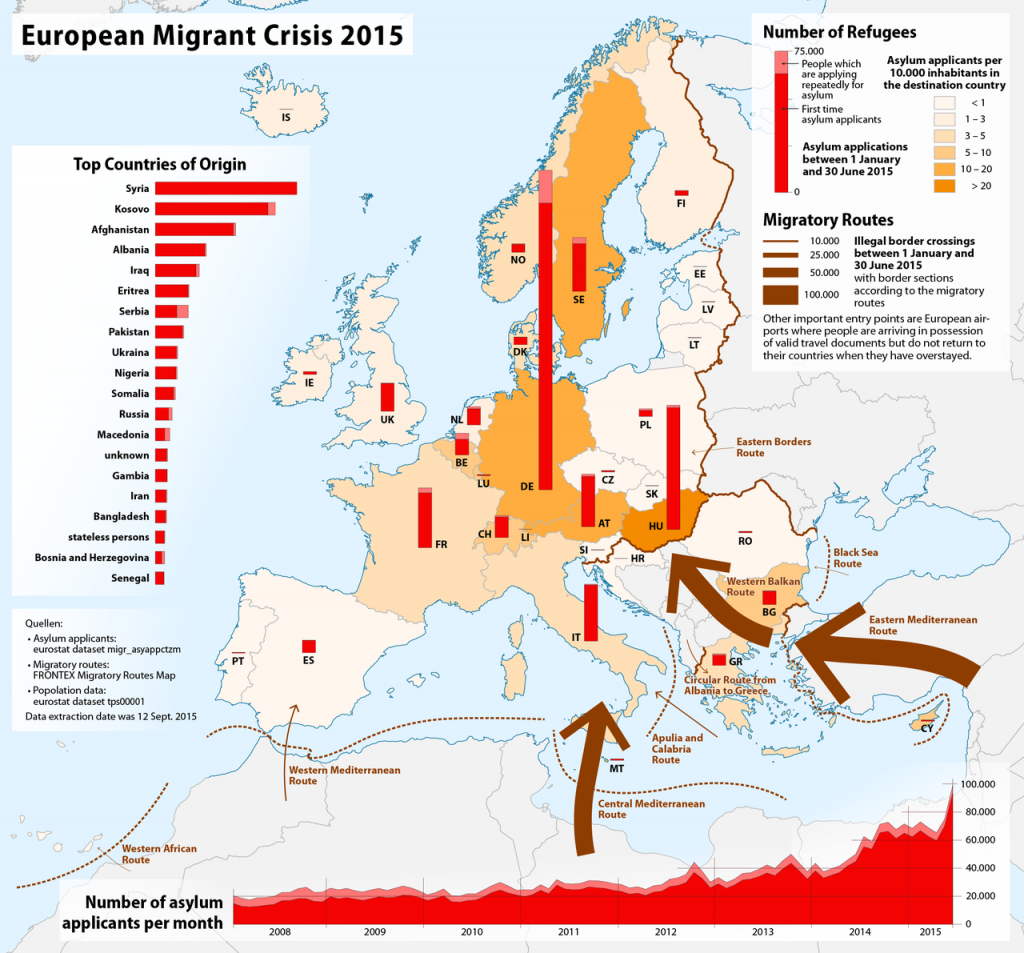
From approximately 2014 to 2016 large numbers of people came to Europe. These events came to be known as “refugee crisis”. The circumstances and their perceptions are extremely controversial and divergent. Some examples how the “refugee crises” was perceived by different people:
From the point of view of a typical “SJW” Europe was cold and heartless, allowed only very few refugees in, tried to make the migration routes as expensive and difficult as possible, and did very little compared to the neighboring countries of Syria. Also, of course, all the help that did occur was justified; the politicians and NGOs advocating for more refugees only did so from humanitarian reasoning.
From the point of view of far right leaning people, the refugee crisis was a welcome opportunity to accelerate the Kalergi-plan, and measures the allowed for mass movement of people were only revoked not to risk to “wake too many people up” (to their secret plans).
The perception of many others lies somewhere between those extremes. Some anomalies and inconsistencies in the public policies are noticeable:
- Migrants into the West commit more crime and have more unemployment than the natives
- Global poverty cannot be solved by migration (see youtube.com/watch?v=LPjzfGChGlE)
- The “replacement migration” is often called a conspiracy theory, but it is literally a recommended policy by the United Nations
- The majority of actual war refugees is stuck in poor countries, and only the richest of the wannabe-migrants can pay for human trafficking
- The demographic makeup of 80% of the 2014-16 migrants into Europe being male, renders the idea, that most of them would be actual refugees, ridiculous. Also, consider this thought experiment: Would the majority of European women have supported “open borders”, as they did, if the gender-imbalance of migrants had been reversed?
- The modern left opposes all sorts of conservatism, traditional gender and family roles, religion, nationalism, group identity and borders. The culture and religion of most migrants is Islam, which endorses conservative, traditional family and gender roles. It has a strong group identity and strict in/out group criteria.
Relevant for the Syria topic. The SCW has created many genuine refugees. People, who’s homes were destroyed, or that to flee. Either because they were affiliated with the Revolutionaries on Government controlled territory or they were suspected of supporting the Government in Rebel controlled territory, etc… Only a fraction of all 2014-16 migrants into Europe were actually from Syria. Much of the rest just abused the situation. Even from the Syrians Europe-migrants there are many that absolutely do not deserve refugee status, for example those that chose to come, and then go back to participate in warfare when they realized Germany is not a paradise with rivers milk, wine and honey.
A final note on this topic; purely my person opinion: I have a lot more respect for Rebels and even ISIL members than for any Syrian male of fighting age that weaseled his way into Europe. In the face of the harsh reality of the civil war any man should stand up for his believes.
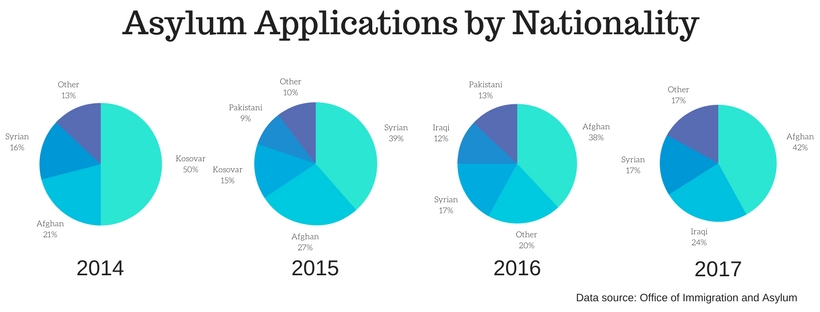
Internally displaced
The violence in Syria caused millions to flee their homes. As of March 2015, Al-Jazeera estimate 10.9 million Syrians, or almost half the population, have been displaced.
Casualties
Total deaths over the course of the conflict in Syria (18 March 2011 – 18 October 2013) based on data from the Syrian National Council.
On 2 January 2013, the United Nations stated that 60,000 had been killed since the civil war began, with UN High Commissioner for Human Rights Navi Pillay saying “The number of casualties is much higher than we expected, and is truly shocking.” Four months later, the UN’s updated figure for the death toll had reached 80,000. On 13 June 2013, the UN released an updated figure of people killed since fighting began, the figure being exactly 92,901, for up to the end of April 2013. Navi Pillay, UN high commissioner for human rights, stated that: “This is most likely a minimum casualty figure.” The real toll was guessed to be over 100,000. Some areas of the country have been affected disproportionately by the war; by some estimates, as many as a third of all deaths have occurred in the city of Homs.
One problem has been determining the number of “armed combatants” who have died, due to some sources counting rebel fighters who were not government defectors as civilians. At least half of those confirmed killed have been estimated to be combatants from both sides, including 52,290 government fighters and 29,080 rebels, with an additional 50,000 unconfirmed combatant deaths. In addition, UNICEF reported that over 500 children had been killed by early February 2012, and another 400 children have been reportedly arrested and tortured in Syrian prisons; both of these claims have been contested by the Syrian government. Additionally, over 600 detainees and political prisoners are known to have died under torture. In mid-October 2012, the opposition activist group SOHR reported the number of children killed in the conflict had risen to 2,300, and in March 2013, opposition sources stated that over 5,000 children had been killed. In January 2014, a report was released detailing the systematic killing of more than 11,000 detainees of the Syrian government.
On 20 August 2014, a new U.N. study concluded that at least 191,369 people have died in the Syrian conflict. The UN thereafter stopped collecting statistics, but a study by the Syrian Centre for Policy Research released in February 2016 estimated the death toll to be 470,000, with 1.9m wounded (reaching a total of 11.5% of the entire population either wounded or killed). A report by the SNHR in 2018 mentioned 82000 victims that had been forcibly disappeared by the Syrian regime, added to 14.000 confirmed deaths due to torture.
More biased BS. Again here is a strong focus on the “evil Assad” and largely omitted are of casualties directly attributed to Rebels. The worst source in this regard is the SNHR, the Syrian Network for Human Rights. On their website they say about themselves “SNHR is an independent, non-partisan, non-governmental, non-profit organization who doesn’t work by any ideology. SNHR was founded in June 2011, and works on documenting human rights violations in Syria and defending the human rights of the Syrian human being at the international level. SNHR was founded through an initiative by Mr. Fadel Abdul Ghany who is currently the chairman of the board of directors.” Merely the professional makeup and the magnitude of their organization already contradicts the claim of being independent and non-partisan. Nothing they claim can or should be believed without thoroughly conducted research done by oneself.
Compared to other, older wars, the SCW is a very slow paced killing machine. The cost of killing an enemy combatant is extremely high. Here are some other aspects of Syrian demographics, to put the war casualties into perspective: On the website worldpopulationreview.com/countries/syria-population/ the number of natural death per minute is given with six. This results in about 700.000 death for 8 years of SCW. From these numbers, the surplus of birth over death within this 8 years would amount to about 3.5 million. The following graph is from that website, based on UN population estimates from 2019. It includes estimates for refugee and migration movement but does not include any projected war related death.
Anomalies in the population pyramid are noticeable, but compared to other wars mostly caused by refugees and not death. For previous, much more disastrous wars North Korea and Belarus are examples, that show a very strong fluctuations in their population pyramids, even though “their wars” were already about 70-80 years ago.
Human rights violations
According to various human rights organizations and United Nations, human rights violations have been committed by both the government and the rebels, with the “vast majority of the abuses having been committed by the Syrian government”.
According to three international lawyers, Syrian government officials could face war crimes charges in the light of a huge cache of evidence smuggled out of the country showing the “systematic killing” of about 11,000 detainees. Most of the victims were young men and many corpses were emaciated, bloodstained and bore signs of torture. Some had no eyes; others showed signs of strangulation or electrocution. Experts said this evidence was more detailed and on a far larger scale than anything else that had emerged from the then 34-month crisis.
The claim of systematic killing of 11.000 detainees comes from the so called United Nations “Caesar Report”. On the Wikipedia article about it we learn: “It was released on 21 January 2014, a day before talks were due to begin at the Geneva II Conference on Syria, and was commissioned by the government of Qatar.” At that time the policy of Qatar of strongly Anti-Assad. That has since changed slightly, because of disputes between Qatar and Saudi Arabia. At the end of the article, we find a surprising breach of the propaganda phalanx. Under the caption “Criticism” it is stated: “In March 2016 the group named Syria Solidarity Movement (SSM) claimed that the allegations that were made by many journalists based on the report were biased or false. They pointed out that that over half of the corpses were showing signs of ordinary death (either in combat or in hospital settings due to various reasons) suggesting that the victims did not die from simple torture or ill-treatment and media therefore misrepresenting the facts. SSM also stated that the accusations made by Caesar, the Carter Ruck report and HRW that the victims were dying in “detention” (or “government custody”) or “by torture” were untrue. The movement has published report where they listed all problems that allegations have.” This is their website: www.syriasolidaritymovement.org. So, counter-propaganda it is? Perhaps… find the reports and decide for yourself. Some excerpts of the counterclaim-report are reproduced here:
There is a pattern of sensational but untrue reports that lead to public acceptance of US and Western military intervention in countries around the world:
-In Gulf War 1, there were reports of Iraqi troops stealing incubators from Kuwait, leaving babies to die on the cold floor. Amnesty International incorrectly “verified” the false accusations.
-Ten years later, there were reports of yellow cake uranium going to Iraq for development of weapons of mass destruction.
-One decade later, there were reports of Libyan soldiers drugged on viagra and raping women as they advanced.
-In 2012, NBC broadcaster Richard Engel was supposedly kidnapped by pro-Assad Syrian militia but luckily freed by Syrian opposition fighters, the “Free Syrian Army”.
All these reports were later confirmed to be fabrications and lies. They all had the goal of manipulating public opinion and they all succeeded in one way or another. Despite the consequences, which were often disastrous, none of the perpetrators were punished or paid any price. The Washington DC politicians and consulting firm who created the incubator hoax, were never even reprimanded let alone punished. Libya is in chaos today yet who has been held to account? Richard Engel understood the kidnapping was a hoax but stayed quiet until the
true story was about to be publicly revealed.
It has been famously said “Those who do not learn from the past are doomed to repeat it.” This report is a critical review of the “Caesar Torture Photos” story. As will be shown, there is strong evidence the accusations are entirely or substantially false.
…
On 20 January 2014, two days before negotiations about the Syrian conflict were scheduled to begin in Switzerland, a sensational report burst onto television and front pages around the world. The story was that a former Syrian army photographer had 55,000 photographs documenting the torture and killing of 11,000 detainees by the Syrian security establishment.
The Syrian photographer was given the code-name ‘Caesar’. The story became known as the “Caesar Torture Photos”. A team of lawyers plus digital and forensic experts were hired by the Carter-Ruck law firm, on contract to Qatar, to go to the Middle East and check the veracity of “Caesar” and his story. They concluded
that “Caesar” was truthful and the photographs indicated “industrial scale killing”. CNN, London’s Guardian and LeMonde broke the story which was subsequently broadcast in news reports around the world.
…
The Syrian government denied the accusations, saying the photos show “ foreign terrorists from several nationalities who had been killed when attacking the military checkpoints and civil institutions” and “part of them are civilians and military personnel who were tortured and killed by the armed terrorist groups because of their support to the state.”
…
Problems with the Story of Mass Torture and Execution in Syria
…
The photographs are in the custody of an opposition organization called the Syrian Association for Missing and Conscience Detainees (SAFMCD). In 2015, they allowed Human Rights Watch (HRW) to study all the photographs which have otherwise been secret. In December 2015, HRW released their report titled “If the Dead Could Speak”. The biggest revelation is that over 46% of the photographs (24,568) do not show people ‘tortured to death” by the Syrian government. On the contrary, they show dead Syrian soldiers and victims of
car bombs and other violence (HRW pp2-3). Thus, nearly half the photos show the opposite of what was alleged. These photos, never revealed to the public, confirm that the opposition is violent and has killed large numbers
of Syrian security
…
In their December 2015 report, HRW said, “ The largest category of photographs, 28,707 images, are photographs Human Rights Watch understands to have died in government custody, either in one of several detention facilities or after being transferred to a military hospital.” They estimate 6,786 dead individuals in the
set.
The key question is how and where did these people die? Were they all detainees tortured and killed by the ‘regime’ as claimed by the Carter Ruck team? Did they all die in “government custody” as claimed by HRW?
These assertions are very dubious. Although we have only been allowed to see a small percentage of the photographs, these suggest victims who died in wide variety of circumstances. Over 80% of the photographs are from branches 227 (Damascus) and 215 (Secret Raids and Intrusions). In their work at the borders and within conflict zones, they would encounter all the following: dead and injured opposition fighters, dead and injured civilians, dead and injured Syrian soldiers and allies. Some of the victims may have been prisoners executed by one of the armed opposition groups. When encountering victims of the conflict, the Syrian military would transfer the bodies to the military hospitals where the injured could be treated and the deceased processed and buried.
…
In summary, the photos and the deceased are real. But how they died and the circumstances are unclear. There is strong evidence some died in conflict. Others died in the hospital. Others died and their bodies were decomposing before they were picked up. These photographs seem to document a war time situation where many combatants and civilians are killed. It seems the military hospital was doing what it had always done: maintaining a photographic and documentary record of the deceased. Bodies were picked up by different military or intelligence branches. While some may have died in detention; the big majority probably died in the conflict zones. The accusations by ‘Caesar’, the Carter Ruck report and HRW that these are all victims of “death in detention” or “death by torture” or death in ‘government custody” are almost certainly false.
…
The true identity of “Caesar” is probably not as claimed. Carter Ruck Report says “This witness who defected from Syria and who had been working for the Syrian government was given the code-name ‘Caesar’ by the inquiry team to protect the witness and members of his family.” (CRR p12) However if his story is true, it would be easy for the Syrian government to determine who he really is. After all, how many military photographers took photos at Tishreen and Military 601 Hospitals during those years and then disappeared? According to the Carter Ruck report, Caesar’s family left Syria around the same time. Considering this, why is “Caesar” keeping his identity secret from the western audience?
Why does “Caesar” refuse to meet even with highly sympathetic journalists or researchers?
Caesar’s story changes in significant ways over time. Based on December 2013 interviews, the Carter Ruck report says, “The inquiry team was informed by ‘Caesar’ that for the last three years his only job together with
others in his section, was to photograph and document bodies of detainees who had been killed.” (CRR p12)
But in interviews with SNHR in summer 2015, ‘Caesar’ changes the account to include victims of “massacres” plus “some of the victims’ bodies belonged to armed opposition groups who were killed or injured during
clashes with government forces”.
…
The prosecutors portray simple administrative procedures as mysterious and sinister.
The Carter Ruck inquiry team falsely claimed there were about 11,000 tortured and killed detainees. They then posed the question: Why would the Syrian government photograph and document the people they just killed?
The Carter Ruck Report speculates that the military hospital photographed the dead to prove that the “orders to kill” had been followed. The “orders to kill” are assumed.
A more logical explanation is that dead bodies were photographed as part of normal hospital / morgue procedure to maintain a file of the deceased who were received or treated at the hospital.
The same applies to the body labeling / numbering system. The Carter Ruck report suggest there is something mysterious and possibly sinister in the coded tagging system. But all morgues need to have a tagging and identification system.
…
Many of the photos at the SAFMCD website have been manipulated. The information card and tape identity are covered over and sections of documents are obscured. It must have been very time consuming to do this for thousands of photos. The explanation that they are doing this to ‘protect identity’ is not credible since the faces of victims are visible. What are they hiding?
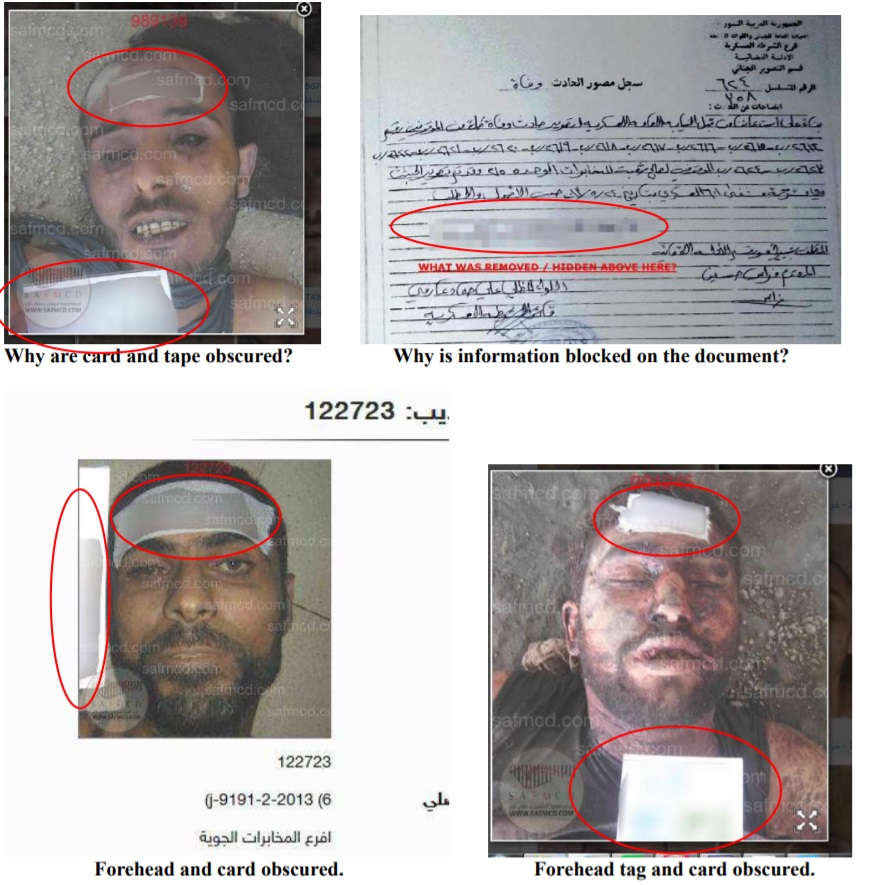
Above is an example of this manipulation from the report. Below is a frame from a video where a Rebel group, documented its own crimes:
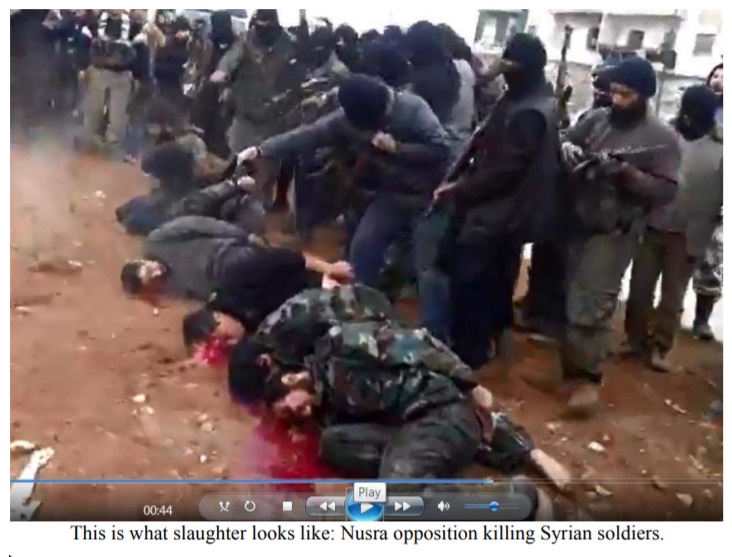
Below is an example where ISIL held an atrocity show. ISIL recruits of seemingly very young age kill Syrian army recruits.
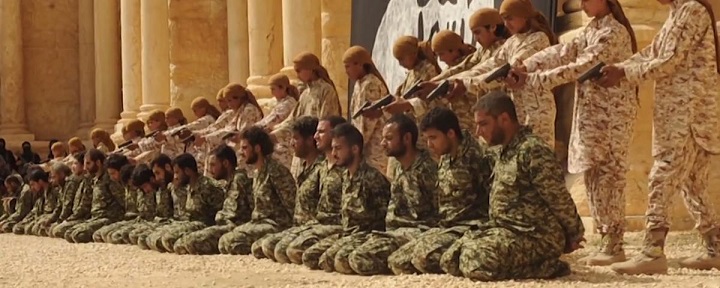
Below two more examples. A FSA soldier eating a raw heart of a killed Syrian army soldier to the left. To the right is a member of the rebel group “Zinki”, holding the severed head of a 12 year old boy, that he just killed. The boy was supposedly accused of being an “Assad spy”. There is no credible footage of Syrian army soldiers engaging in similar activities or presenting themselves in an deliberately evil manner.
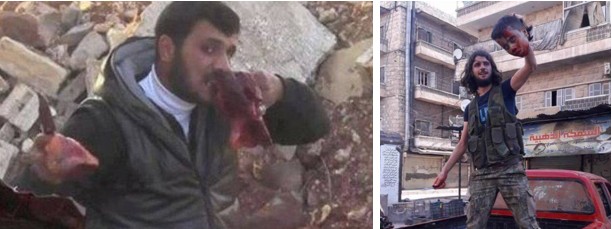
Back to the Wikipedia article:
UN reported also that “siege warfare is employed in a context of egregious human rights and international humanitarian law violations. The warring parties do not fear being held accountable for their acts.” Armed forces of both sides of the conflict blocked access of humanitarian convoys, confiscated food, cut off water supplies and targeted farmers working their fields. The report pointed to four places besieged by the government forces: Muadamiyah, Daraya, Yarmouk camp and Old City of Homs, as well as two areas under siege of rebel groups: Aleppo and Hama. In Yarmouk Camp 20,000 residents are facing death by starvation due to blockade by the Syrian government forces and fighting between the army and Jabhat al-Nusra, which prevents food distribution by UNRWA. In July 2015, the UN quietly removed Yarmouk from its list of besieged areas in Syria, despite not having been able deliver aid there for four months, and declined to explain why it had done so.
ISIS forces have been accused by the UN of using public executions, amputations, and lashings in a campaign to instill fear. “Forces of the Islamic State of Iraq and al-Sham have committed torture, murder, acts tantamount to enforced disappearance and forced displacement as part of attacks on the civilian population in Aleppo and Raqqa governorates, amounting to crimes against humanity”, said the report from 27 August 2014.
Enforced disappearances and arbitrary detentions have also been a feature since the Syrian uprising began. An Amnesty International report, published in November 2015, accused the Syrian government of forcibly disappearing more than 65,000 people since the beginning of the Syrian Civil War. According to a report in May 2016 by the Syrian Observatory for Human Rights, at least 60,000 people have been killed since March 2011 through torture or from poor humanitarian conditions in Syrian government prisons.
The “Syrian Observatory for Human Rights”, SOHR is quite similar to the above mentioned SNHR, but even more suspicious. For a long time it was run by a single man from Great Britain and presented arbitrary atrocity stories, that were uncritically parroted by the western MSM. There are some exceptions though, and one is even linked on Wikipedia. In 2012 a German newspaper researched the topic and corroborated that the SOHR is a heavily biased operation with little credibility: www.sueddeutsche.de/politik/syrische-beobachtungsstelle-fuer-menschenrechte-ominoese-protokollanten-des-todes-1.1522443-0#seite-2
In February 2017, Amnesty International published a report which accused the Syrian government of murdering an estimated 13,000 persons, mostly civilians, at the Saydnaya military prison. They said the killings began in 2011 and were still ongoing. Amnesty International described this as a “policy of deliberate extermination” and also stated that “These practices, which amount to war crimes and crimes against humanity, are authorised at the highest levels of the Syrian government.” Three months later, the United States State Department stated a crematorium had been identified near the prison. According to the U.S., it was being used to burn thousands of bodies of those killed by the government’s forces and to cover up evidence of atrocities and war crimes. Amnesty International expressed surprise at the claims about the crematorium, as the photographs used by the US are from 2013 and they did not see them as conclusive, and fugitive government officials have stated that the government buries those its executes in cemeteries on military grounds in Damascus. The Syrian government denied the allegations.
The source given is www.nytimes.com/2017/05/15/world/middleeast/syria-assad-prison-crematory.html. The coordinates in the pictures are wrong, but the location can be found by searching for the name on google maps, where the prison gets a 1.9 stars review. This is because of many “troll” reviews. Certainly, this prison, makes for a horrible experience. For one, it is in a poor country, and the war certainly aggravates animosities towards prisoners. While it is possible that there is a crematorium that is used to dispose corpses of legal or extrajudicial executed prisoners, claiming that the pictures show a crematorium is pure pareidolia – and propaganda. The NYT cites multiple witnesses that have smelled burned hair and one that saw black smoke. Hmm…. What really smell here, at least in the figurative sense, is this story – it reeks of atrocity propaganda.
By July 2012, the human rights group Women Under Siege had documented over 100 cases of rape and sexual assault during the conflict, with many of these crimes believed to have been perpetrated by the Shabiha and other pro-government militias. Victims included men, women, and children, with about 80% of the known victims being women and girls. A report by the United Nations Human Rights Council states that “women and girls as young as nine are being sold as slaves to ISIS soldiers who regularly beat them and rape them, re-sell them, and, if they try to escape, kill them.”
That on the other hand sounds much more plausible. Rape and war usually go together.
On September 11, 2019, the UN investigators said that air strikes conducted by the US-led coalition in Syria have killed or wounded several civilians, denoting that necessary precautions were not taken leading to potential war crimes.
As the violence intensifies in north-west Syria, thousands of women and children are reportedly kept under “inhumane conditions” in a remote camp, said UN-appointed investigators.
Epidemics
The World Health Organization has reported that 35% of the country’s hospitals are out of service. Fighting makes it impossible to undertake the normal vaccination programs. The displaced refugees may also pose a disease risk to countries to which they have fled. 400,000 civilians were isolated by the Siege of Eastern Ghouta from April 2013 to April 2018, resulting in acutely malnourished children according to the United Nations Special Advisor, Jan Egeland, who urged the parties for medical evacuations. 55,000 civilians are also isolated in the Rukban refugee camp between Syria and Jordan, where humanitarian relief access is difficult due to the harsh desert conditions. Humanitarian aid reaches the camp only sporadically, sometimes taking three months between shipments.
Formerly rare infectious diseases have spread in rebel-held areas brought on by poor sanitation and deteriorating living conditions. The diseases have primarily affected children. These include measles, typhoid, hepatitis, dysentery, tuberculosis, diphtheria, whooping cough and the disfiguring skin disease leishmaniasis. Of particular concern is the contagious and crippling Poliomyelitis. As of late 2013 doctors and international public health agencies have reported more than 90 cases. Critics of the government complain that, even before the uprising, it contributed to the spread of disease by purposefully restricting access to vaccination, sanitation and access to hygienic water in “areas considered politically unsympathetic”.
Are there trade sanctions in place that hinder or prevent Syrians from receiving necessary medical supplies and treatment? Well, the Russia-affiliated and pro-Assad news sources certainly claim so. Would western politicians hesitate to put sanctions on a country that primarily hurt the poorest and weakest only to potentially undermine an unwelcome ruler of a foreign country? Concerning this question the comment of Madeleine Albright comes to mind, concerning sanctions on Iraq, dated May 12, 1996, CBS; reporter: “We have heard half a million of children have died. I mean, that is more children than have died in Hiroshima. You know, is the price worth it?” Albright answered: “I think this is a very hard choice, but we think the price is worth it”
Humanitarian aid
The conflict holds the record for the largest sum ever requested by UN agencies for a single humanitarian emergency, $6.5 billion worth of requests of December 2013. The international humanitarian response to the conflict in Syria is coordinated by the United Nations Office for the Coordination of Humanitarian Affairs (UNOCHA) in accordance with General Assembly Resolution 46/182. The primary framework for this coordination is the Syria Humanitarian Assistance Response Plan (SHARP) which appealed for US$1.41 billion to meet the humanitarian needs of Syrians affected by the conflict. Official United Nations data on the humanitarian situation and response is available at an official website managed by UNOCHA Syria (Amman). UNICEF is also working alongside these organizations to provide vaccinations and care packages to those in need. Financial information on the response to the SHARP and assistance to refugees and for cross-border operations can be found on UNOCHA’s Financial Tracking Service. As of 19 September 2015, the top ten donors to Syria were United States, European Commission, United Kingdom, Kuwait, Germany, Saudi Arabia, Canada, Japan, UAE, and Norway.
The difficulty of delivering humanitarian aid to people is indicated by the statistics for January 2015: of the estimated 212,000 people during that month who were besieged by government or opposition forces, 304 were reached with food. USAID and other government agencies in US delivered nearly $385 million of aid items to Syria in 2012 and 2013. The United States has provided food aid, medical supplies, emergency and basic health care, shelter materials, clean water, hygiene education and supplies, and other relief supplies. Islamic Relief has stocked 30 hospitals and sent hundreds of thousands of medical and food parcels.
Other countries in the region have also contributed various levels of aid. Iran has been exporting between 500 and 800 tonnes of flour daily to Syria. Israel supplied aid through Operation Good Neighbor, providing medical treatment to 750 Syrians in a field hospital located in Golan Heights where rebels say that 250 of their fighters were treated. Israel established two medical centers inside Syria. Israel also delivered heating fuel, diesel fuel, seven electric generators, water pipes, educational materials, flour for bakeries, baby food, diapers, shoes and clothing. Syrian refugees in Lebanon make up one quarter of Lebanon’s population, mostly consisting of women and children. In addition, Russia has said it created six humanitarian aid centers within Syria to support 3000 refugees in 2016.
Return of refugees
Another aspect of the post war years will be how to repatriate the millions of refugees. The Syrian government has put forward a law commonly known as “law 10”, which could strip refugees of property, such as damaged real estate. There are also fears among some refugees that if they return to claim this property they will face negative consequences, such as forced conscription or prison. The Syrian government has been criticized for using this law to reward those who have supported the government. However, the government denies this and has expressed that it wants the return of refugees from Lebanon. In December 2018, it was also reported that the Syrian government has started to seize property under an anti-terrorism law, which is affecting government opponents negatively, with many losing their property. Some people’s pensions have also been cancelled.
Peace process and de-escalation zones
During the course of the war, there have been several international peace initiatives, undertaken by the Arab League, the United Nations, and other actors. The Syrian government has refused efforts to negotiate with what it describes as armed terrorist groups. On 1 February 2016, the UN announced the formal start of the UN-mediated Geneva Syria peace talks that had been agreed on by the International Syria Support Group (ISSG) in Vienna. On 3 February 2016, the UN Syria peace mediator suspended the talks. On 14 March 2016, Geneva peace talks resumed. The Syrian government insisted that discussion of Bashar-al-Assad’s presidency “is a red line”, however Syria’s President Bashar al-Assad said he hoped peace talks in Geneva would lead to concrete results, and stressed the need for a political process in Syria.
A new round of talks between the Syrian government and some groups of Syrian rebels concluded on 24 January 24, 2017 in Astana, Kazakhstan, with Russia, Iran and Turkey supporting the ceasefire agreement brokered in late December 2016. The Astana Process talks was billed by a Russian official as a complement to, rather than replacement, of the United Nations-led Geneva Process talks. On 4 May 2017, at the fourth round of the Astana talks, representatives of Russia, Iran, and Turkey signed a memorandum whereby four “de-escalation zones” in Syria would be established, effective of 6 May 2017.
On September 18, 2019, Russia accused the United States and Syrian rebels of obstructing the evacuation process of a refugee camp in southern Syria.
On September 28, 2019, Syria’s top diplomat demanded the foreign forces, including that of US and Turkey, to immediately leave the country, saying that the Syrian government holds the right to protect its territory in all possible ways if they remain.
President RT Erdogan said Turkey was left with no choice other than going its own way on Syria ‘safe zone’ after deadline to co-jointly establish a “safe zone” with the US in northern Syria expired in September. The U.S. indicated it will withdraw its forces from northern Syria after Turkey warned of incursion in the region that could instigate fighting with American-backed Kurds.
Destruction and reconstruction
United Nations authorities have estimated that the war in Syria has caused destruction reaching to about $400 billion.
While the war still ongoing, Syrian President Bashar Al-Assad claimed that Syria would be able to rebuild the war-torn country on its own. As of July 2018, the reconstruction is estimated to cost a minimum of US$400 billion. Assad claims to be able to loan this money from friendly countries, Syrian diaspora and the state treasury. Iran has expressed interest in helping rebuild Syria. International donors have been suggested as one financier of the reconstruction. As of November 2018, reports emerged that rebuilding efforts had already started. It was reported that the biggest issue facing the rebuilding process is the lack of building material and a need to make sure the resources that do exist are managed efficiently. The rebuilding effort have so far remained at a limited capacity and has often been focused on certain areas of a city, thus ignoring other areas inhabited by disadvantaged people.
According to a Syrian war monitor, over 120 Churches have been damaged or demolished by all sides in Syrian war since 2011.
That is the end of the Wikipedia article. Most of the question I have posed above remain unanswered. Here are some very interesting aspects and reports would be of interest and should have been included, but are missing in the Wikipedia main article, found on https://worldaffairs.blog/2017/05/09/us-and-allies-created-funded-armed-isis:
- Hillary Clinton wrote to her campaign manager, John Podesta, that “Qatar and Saudi Arabia are providing clandestine financial and logistic support to ISIS and other radical Sunni groups in the region.”
- Joe Biden also revealed the same facts about Saudi Arabia and Qatar in a colorful speech at Harvard University.
- A 2009 State Dept. confidential cable admitted: “Saudi Arabia is the #1 sponsor of terrorist groups all over the world.”
- 4-Star General Martin Dempsey – Chairman of the Joint Chiefs of Staff – said during a Senate hearing, “I know many Arab allies who fund ISIS.”
- NATO Commander Gen. Wesley Clark said, “our friends and allies funded ISIS.”
- Presidential candidate Evan McMullin tweeted that his role in CIA was to convince al-Qaeda to work with the U.S.
- Officials of DIA (Defense Intelligence Agency) warned in a Pentagon memo in 2012 that the US should stop arming the Syrian rebels since the opposition group in Syria was primarily made up of Muslim Brotherhood, al-Qaeda and Salafists (groups like ISIS that follow extremist version of Sunni Islam).
- John Kerry, as the Sec. of State, admitted that the U.S. sought to use ISIS as a leverage against Assad during negotiations. In the same audio, Kerry talks about how the U.S. has spent a lot of money and efforts overthrowing Assad; and how Putin came in and weakened ISIS.
- Defense Minister of Israel said in an interview that ISIS attacked Israel only once, but ISIS apologized immediately! This is an extraordinary statement in so many ways, if you think about it. No wonder many people say that ISIS stands for “Israeli Secret Intelligence Services.”
- Israel’s Military Intelligence Chief said during a speech that “Israel prefers ISIS over the Syrian government.”
- A prominent Israeli think tank said that ISIS is a “useful tool against Iran and Hezbollah.”
- UN Observers in Golan Heights have reported that Israel arms Syrian rebels and assists wounded rebels
- Israeli newspapers reported in 2017 that Israel has been arming, funding many Islamic militant groups in Golan heights for many years
- Thomas Friedman of The New York Times wrote two pieces asserting that ISIS is better than Assad (2015 article, 2017 article).
Timeline
One wonders why this is missing … Next on the show are some of the key turning points and highlights of the SCW in chronological order.
May 2013
US Senator John McCain, illegally visited Syria to meet members of the FSA. He became one of the most outspoken proponents of ousting Assad – by any means necessary. Nothing unusual for McCain, he pushed for more war and more intervention in every US related conflict throughout his political life. Claims have been made that McCain met with (later) ISIS members directly, or even organized the implementation of the “Abu Bakr al-Baghdadi Persona” during this visit, but this are very vague.
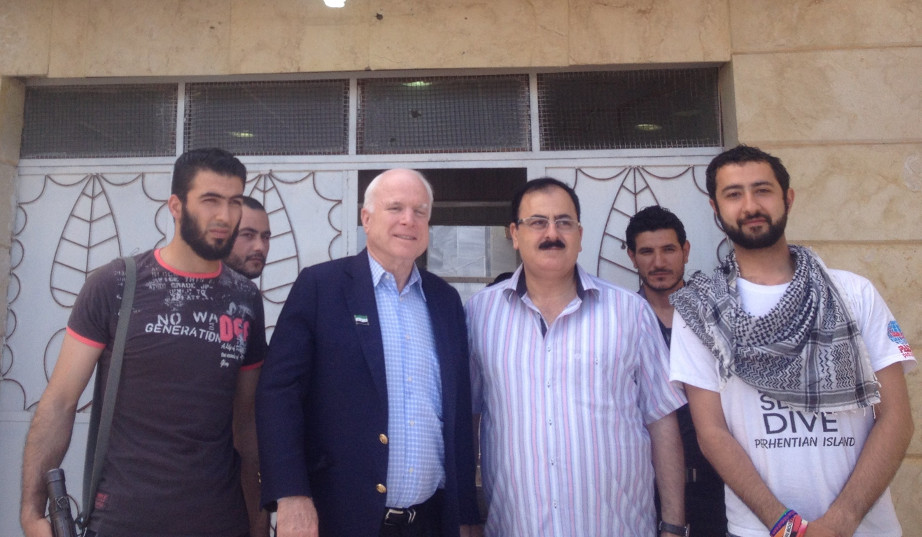
By this time about three large factions have formed. During the two prior years, more and more gains by anti-government forces were maid. Parts of the Syrian Army deserted and formed the “Free Syrian Army”, the FSA. For the map below: The red territory is controlled by the government, the green area is controlled by FSA or similar rebel factions, and the yellow area is controlled by Kurdish groups. The opposition is strong in the Idlib area, around Al Raqqa and along the Euphrates. There are also opposition controlled pockets throughout the country. The Government has pockets in Deir ez-Zor, and the Idlib region.
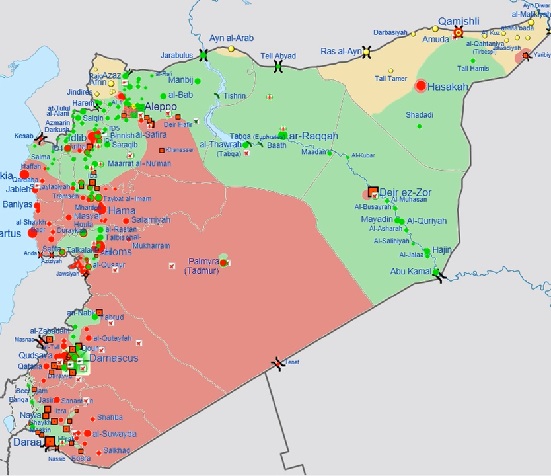
August 2013
The first “chemical attack controversy” happened. The West accused Assad of having killed several hundred people with chemical weapons, even though he agreed before to give up on all these weapons. Also, US President Obama warned Assad before that the usage of chemical weapons would be a “red line”, and would lead to direct military intervention.
Recall the Wikipedia statement about that above. The wording is carefully crafted to imply that the Syrian army was also the perpetrator in this event, without actually stating it. The MSM and the everyday discourse in Western politics is more blunt about their wishful theory and accuse Assad directly. One of the heaviest hitting arguments, aside from the cui-bono considerations, against that interpretation comes from a Report by former UN Weapons Inspector Richard Lloyd and MIT Professor Theodore A. Postol: “Possible Implications of Faulty US Technical Intelligence in the Damascus Nerve Agent Attack of August 21, 2013”. The two experts found that despite official claims and “intelligence,” the nerve-agent attack in East Ghouta “could not possibly” have come from the center or even the Eastern edge of regime-controlled territory. Links to more corroborating reports and evidence that Syrian rebels had the means to execute the nerve-gas attack in a false-flag style themselves, can be found here: www.thenewamerican.com/usnews/foreign-policy/item/17443-mit-report-obama-used-bogus-intelligence-to-push-syria-war
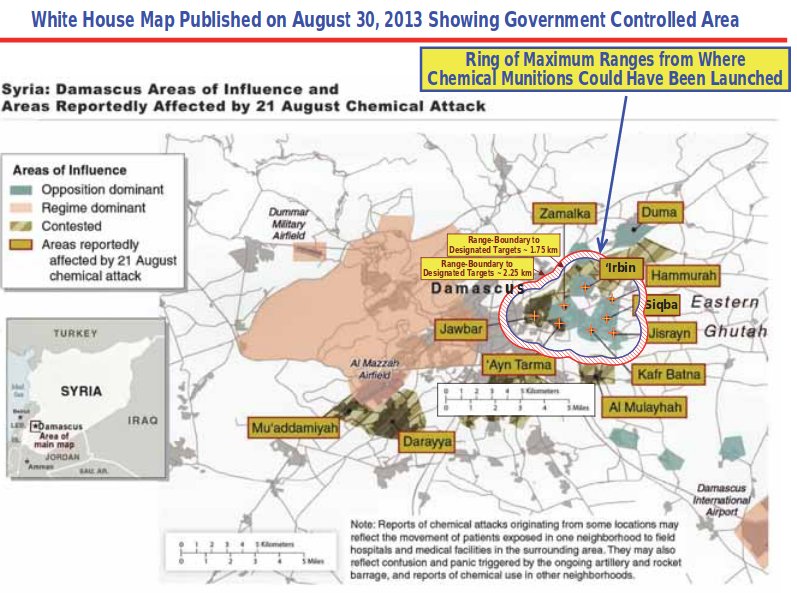
July 2014
The Telegraph reported: Abu Bakr al-Baghdadi ridiculed for flashy wristwatch. The Islamic State leader prompts confusion among his followers after appearing in his first public address wearing a wristwatch that resembles an expensive Omega or Rolex … The emergence of the highly-secretive Abu Bakr al-Baghdadi from the shadow of Iraq’s sectarian crisis put a face to the threat of a global Islamic caliphate … The Islamic State leader spoke publicly for the first time at Mosul’s Great Mosque of Friday, an intervention in which he called on the world’s Muslims to “obey” him as “the leader who presides over you” … But the self-anointed ‘Caliph Ibrahim’ also brought a touch of branding into the bloody conflict, with many who have seen the 20-minute sermon commenting on his bulky and expensive wristwatch … Video footage of Baghdadi’s appearance, the veracity of which is disputed by the Iraqi government, was posted on Youtube and prompted an outpouring of confused comments on social media … But Baghdadi’s recorded appearance was only the third known sighting of the leader. There are two other photographs, one dating from his 2005-2009 imprisonment in a US detention camp in Iraq.
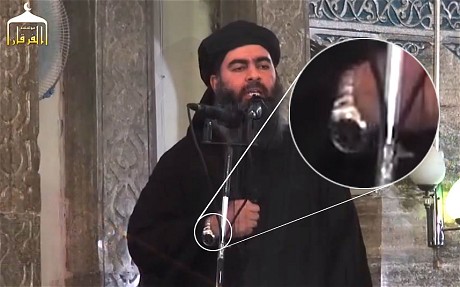
The rise of ISIL happened in 2014. They became the most important and powerful terrorist organization within many months. And even more than that, they seemed to be on course to make their planned Caliphate a reality, with major victories and conquests in Syria and Iraq in Summer 2014. In Syria ISIL conquered most of its territory from other rebel groups and not from the government. They also moved against the Kurds in the North. The first setback for ISIL was the battle of Kobane. Brought to the brink of destruction this city at the border to Turkey was successfully defended with the help of US air strikes. While Turkey watched reluctantly the slaughter of Kurdish civilians, other NATO countries did help. This was the start of the “Coalition”. An alliance of Kurdish and also Arab units that constituted the ground forces and NATO countries that mostly contributed with their air-forces.
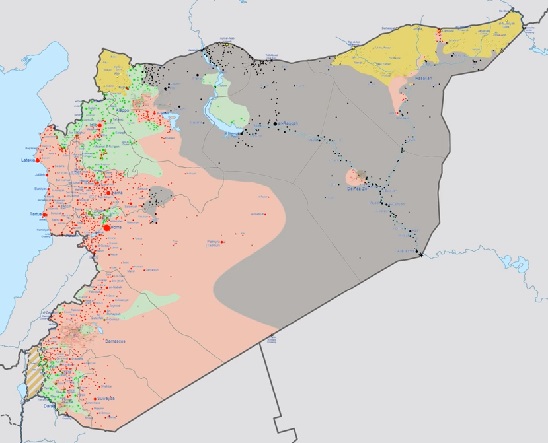
With the coalition air force active in the north, ISIL started to get pushed back on that front. At the same time ISIL had some success in engaging the SAA. They conquered Palmyra and used that setting for another display of their evilness and depravity with public mass executions and the destruction of the cultural heritage of Palmyra.
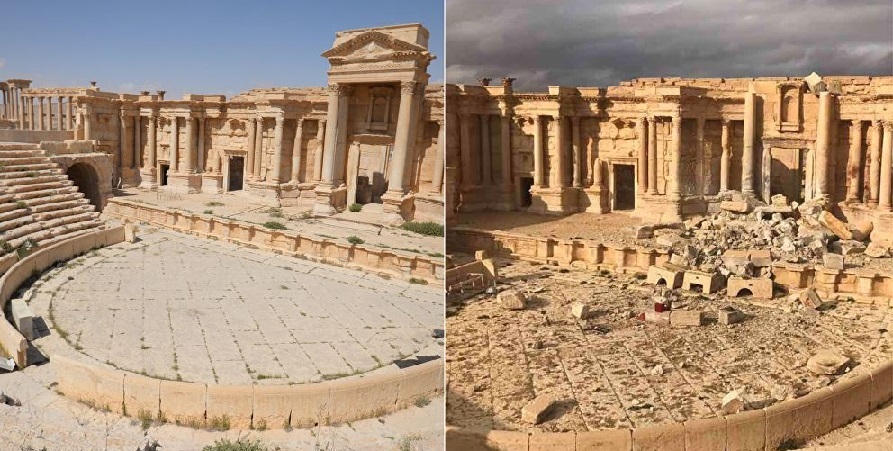
November 2015
What significantly changed the course of the war, was the active engagement of Russia at the end of 2015. At first there was little progress. Russia claimed on the world stage, that it increased its help to Syria because of ISIL, but most of the Russian air-strikes were directed against the FSA, Al Nusra and other “moderate” rebels. It took over a year before the results of the Russian efforts became fruitful.
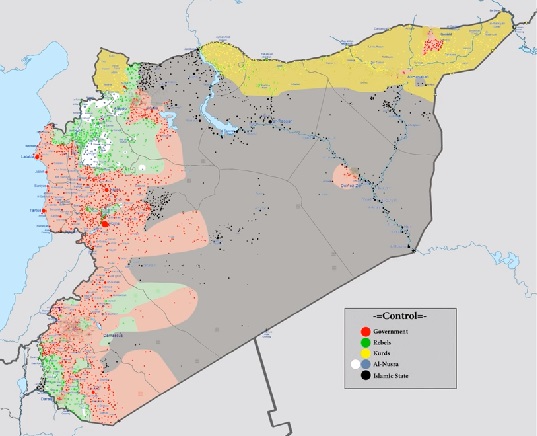
December 2016
After more then one year of active Russian intervention, progress of the SAA and hysterical tear-jerking propaganda, some citizen activists started the “Civil march for Aleppo” in December 2016, because they got so upset that Assad is trying to capture back the second biggest city of the country from Islamic terrorists. They wanted to walk from Berlin to Aleppo on foot. By the time they started walking the battle was over, and Aleppo freed. One needs to pay respect to their dedication, some followed through with their commitment, they did the journey. From 3500 only 12 reached Syria.
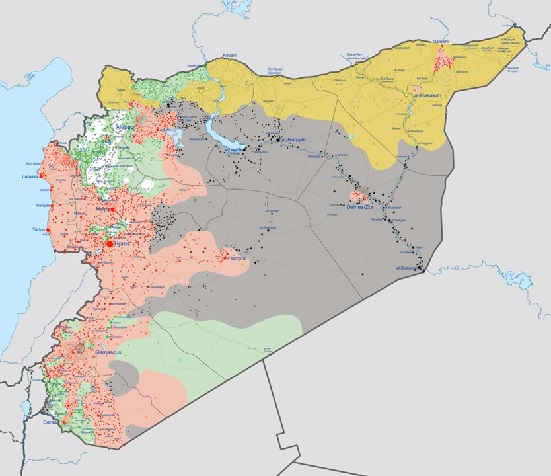
Only a few weeks after the citizen activists started walking, the SAA and Russia reaped the biggest sucessess they had so far, they recaptured Aleppo. Many of the previously “ruling” Jihadists fled to, or rather were granted passage, to Idlib. Of course it is hard to say for outsiders, if the common people, the citicen of Aleppo are now happier or better off, but this is quite plausible. Reconstruction quickly began…
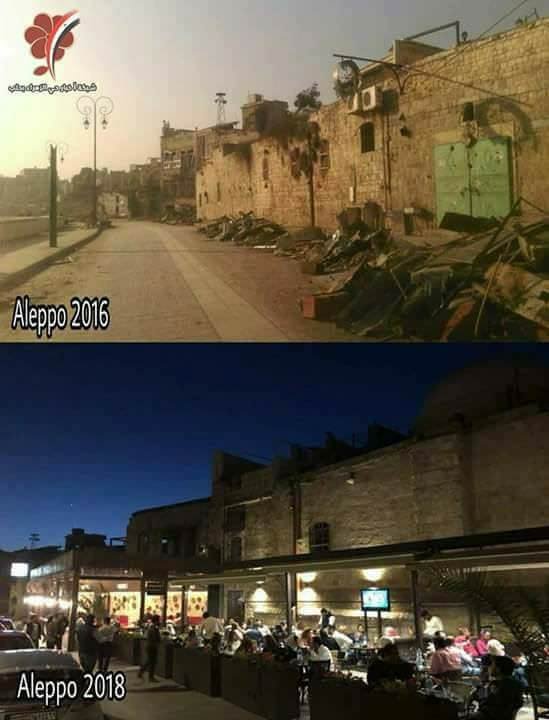
February 2017
On the “Oscar” website one can read: THE WHITE HELMETS is the 2017 Oscar Winner for Documentary (Short Subject). Congratulations to Orlando von Einsiedel and Joanna Natasegara. About THE WHITE HELMETS: In the chaos of war-torn Syria, unarmed and neutral civilian volunteers known as “the white helmets” comb through the rubble after bombings to rescue survivors. Although they have already saved more than 60,000 lives since 2013, these brave first responders continue to place themselves in danger every day.
No. Pretty much everything about this paragraph is false. They are not neutral, but work exclusively in rebel held areas. They may be not armed when they make their movies, but some of their members are no other occasions. There are plenty of eyewitness statements of actual civilians on video that confirm that this group does not help at all, only makes videos pretending to. The supposed leader of this group in Syria could not attend the ceremony because he was refused entry into the US, because he was on a Terrorist watch list. Plenty of video and picture footage exists showing White Helmets appearing together with radical Islamist fighters. The group was founded in 2013 in Turkey, by James Le Mesurier, a former British military intelligence officer. The best smack-down of the whole propaganda ploy comes from James Corbett:
www.corbettreport.com/whitehelmets … read through that, check the sources … and then you will not just know the truth about this group. As a corollary one gets an example that large conspiracies are real and how they potentially function.
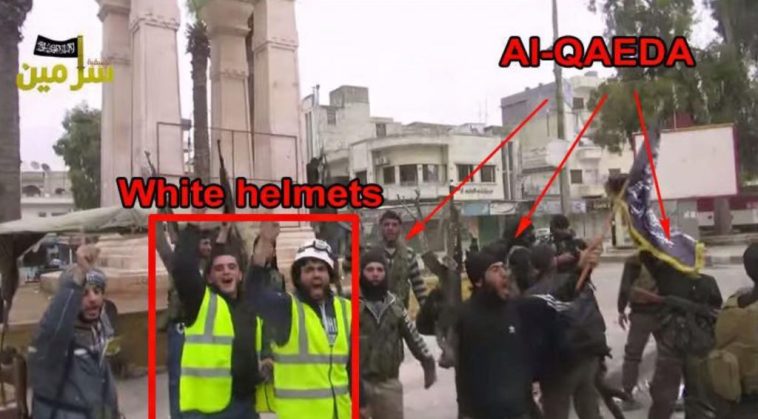
April 2017
This was quite an eventful month. The second large use of chemical weapons has allegedly taken place. I will cite here parts of the take of James Corbett on this matter, from: https://www.corbettreport.com/the-syriastrikes-an-open-source-investigation
As you know by now, President Trump ordered missile strikes on the Al Shayrat airfield in Syria Thursday night. Starting at 8:40 PM Eastern Daylight Time, the US guided-missile destroyers USS Ross and USS Porter launched a total of 59 Tomahawk Land Attack Missiles. This being the age of the internet, you can watch the missiles being launched (at a cost of $1.41 million a pop) in a series of YouTube videos kindly supplied by the Pentagon.
For his part, the teleprompter-in-chief handled his ceremonial role perfectly, intoning all the usual political blather that we have come to expect from the Bush/Clinton/Bush/Obama/Trump puppets. To wit: “Tonight, I ordered a targeted military strike blah de blah de blah vital national security interest of the United States da dee doo dee dum no dispute that Syria used banned chemical weapons etc., etc., I call on all civilized nations to join us yadda yadda.” You get the gist.
However, somehow with this action Trump managed to throw the war hawks a bone without any other follow up intensification of US involvement. Corbett and his readers collected plenty of evidence that foul play is at work here, once more…
An example of the western propaganda to support the claim the chemical attack was executed the SAA can be found here : euvsdisinfo.eu/report/the-chemical-attack-on-khan-sheykhun-was-staged-by-the-white-helmets … basically an appeal to the authority of the OPCW. No details, no refutations of long analysis, that destroy the NATO narrative: syrianews.cc/opcw-report-khan-sheikhoun-baseless. This can be shortened quite a bit. Look up Sarin on Wikipedia, search for “skin”. The next picture is from a video, taken by the “White Helmets”:
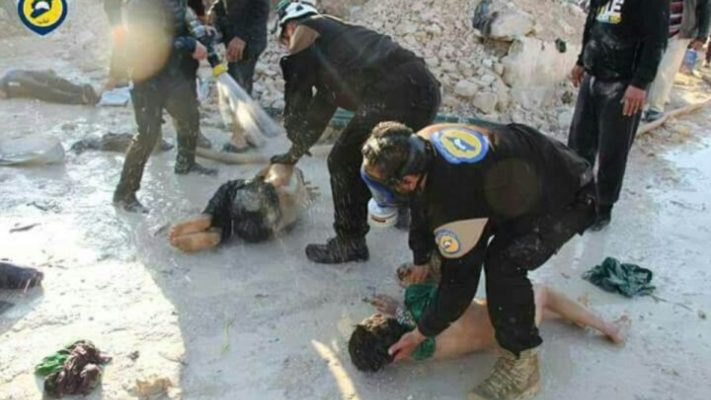
Still in April 2017: Government forces have gained the upper hand by now, and established the “green bus deals”, where Rebels were granted free passage to Idlib for surrendering pockets they held but were surrounded by government forces. Apparently in exchange for that, the rebels also permitted the evacuations of two “pockets” in Idlib. The towns of al-Fu’ah and Kafriya had majority Shia populations and were under the control of government forces. A few thousand civilians were besieged since March 2015. On April 15 a suicide bomber attacked on of the convoys carrying evacuees, in one of the most evil in depraved manners possible: The suicide bomber who killed over 120 people in Syria attracted children toward him by providing crisps before detonating his explosives. The attack occurred when the evacuees anxiously waited at a transit point within rebel-held Rashidin, west of Aleppo. The Russian interpretation of the event can be found here: www.youtube.com/watch?v=N8YOcdvCYis. The opportunity for anti-western propaganda was certainly not lost here, but as far as it is possible to research the events from the internet, this indeed happened as alleged here.
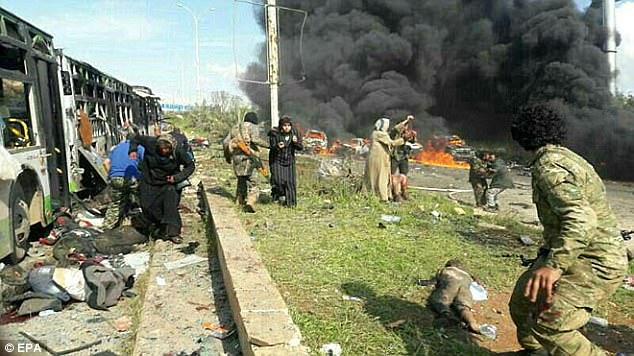
A few month before al Nusra had already “canceled” a similar evacuation agreement, when they burned the busses for the evacuees:
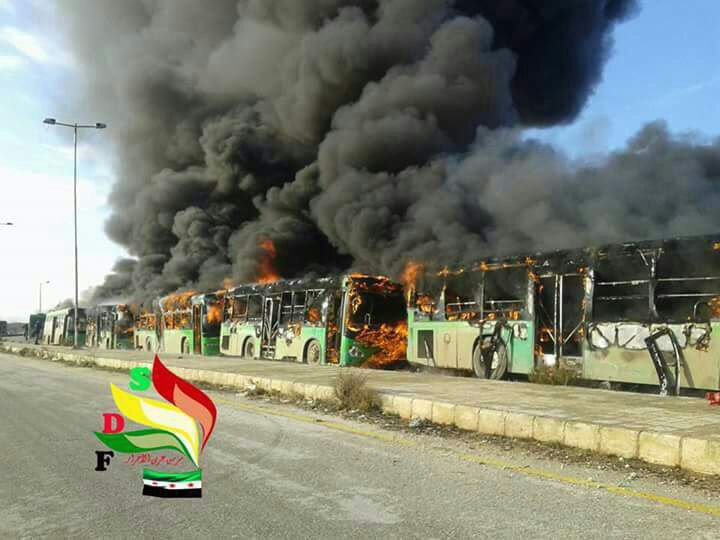
May 2017
US politicians that openly condemn and oppose the US imperialistic machinery are few and far between. Especially those who have already reached the height of their political ambitions. Obama was hailed as the “peace president”, simply for not being Bush and some lip-service. But then continued the usual foreign policy, possibly killed even more innocent Muslims and did not even bother to return the undeserved Nobel peace prize. The more promising “peace candidate” Ron Paul never got a chance to put his words into actions. Perhaps Tulsi Gabbard will? At around this time she made some relevant Twitter comments: “Trump support of Saudi Arabia-a brutal theocracy & biggest sponsor of terrorism & the Wahhabi Salafi ideology fueling it-is a HUGE betrayal”, “Opening counter-terrorism center in Saudi is a farce; Saudi is #1 exporter of Wahhabi Salafi jihadist ideology that fuels grps like ISIS/AQ”, “Trump Admin talks tough on ISIS & terrorism, while selling weapons to the greatest supporter of terror groups like al-Qaeda & ISIS”.
September 2017
The elite unite “Tiger Forces” reached the SAA controlled pocket in Deir Ezzor, ending 3 years of siege. The SAA forces were holding back many attacks by ISIL under difficult circumstances. Their commander Issam Zahreddine sure knew his trade and how to give a good presentation of himself. He became was hero in Syria and with Assad supporters. Of course the west could not tolerate such a heroic symbol: Zahreddine was added to a European Union sanctions list for his role in “violent repression against the civilian population, including during the siege of Baba Amr in February 2012.” He was killed by a mine only about one month after the end of the siege.
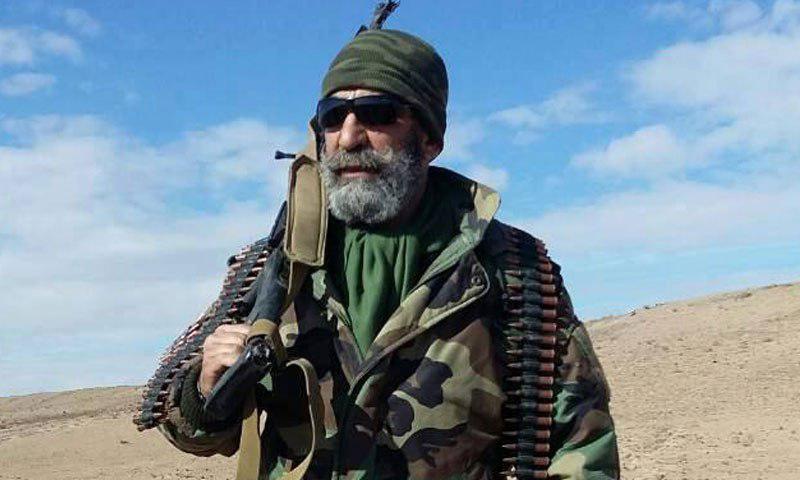
October 2017
Syrian Democratic Forces (SDF) fully capture Raqqa City from ISIL. Like much of the rest of the SDF campaign the city was conquered by the following pattern: A) SDF ground-forces identify possible enemy positions. B) The US airforce obliterates this positions. C) SDF ground-forces move in. This explains their moderate losses and why Raqqa City looked like this after being liberated.
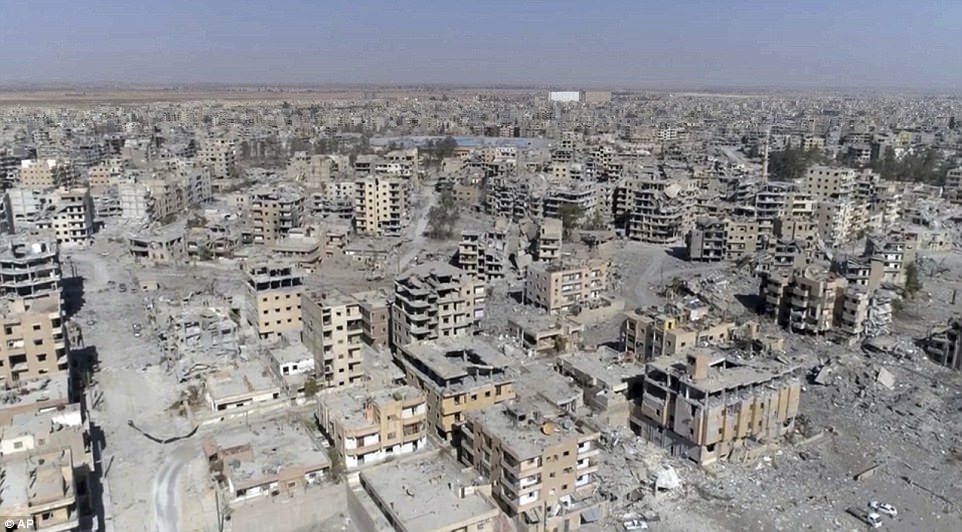
April 2018
Another round of red-gas-line-crossing false flag attempt was due. And again Corbett and readers collected much information: corbettreport.com/syria-chemical-weapons-attack-an-open-source-investigation.
Later he compiled this summary: https://www.corbettreport.com/episode-368-the-douma-hoax-anatomy-of-a-false-flag
The key aspects are: For one, there were definitely dead bodies, that are allegedly attached to this event: twitter.com/AWAKEALERT/status/982778112000839680
Then there is a video of the alleged “chlorine barrel bomb” … is that even in the same location?
twitter.com/domihol/status/983327733882204161. And here a picture of it:

Shortly before that event, Trump has publicly stated he wants the US to leave Syria. As in the case of one year earlier, this happened at a time where the SAA made significant gains. In the words of the NYT: “As Trump Seeks Way Out of Syria, New Attack Pulls Him Back In”. Hmmm… that kind of activates your almonds, doesn’t it?
The official report by the OPCW claimed that a helicopter of the SAA dropped barrel bombs with chlorine.
Professor Tim Hayward of Edinburgh University published an OPCW technical report that had previously been kept secret: timhayward.wordpress.com/2019/05/13/evidence-that-douma-chemical-attack-was-staged-opcws-unpublished-engineers-report … download the report here. The conclusion is, that the event having been staged by militias is the “only plausible explanation” for the alleged poison gas attack of April 2018 in the Syrian Douma.
The OPCW has confirmed the authenticity of the report and announced an „internal investigation about the unauthorised release of the document“: hitchensblog.mailonsunday.co.uk/2019/05/strange-news-from-the-opcw-in-the-hague-.html
Former MIT scientist and Pentagon advisor Theodore Postol confirmed the report:
thegrayzone.com/2019/05/25/opcw-syria-gas-attack-staged-theodore-postol
Further corroberation followed… some excerpts from steemit.com/news/@caitlinjohnstone/opcw-losing-credibility-as-even-more-revelations-surface-on-douma:
During a recent BBC radio interview, award-winning journalist Jonathan Steele said that he attended a briefing by a new whistleblower from the Organization for the Prohibition of Chemical Weapons (OPCW) investigation into an alleged 2018 chemical attack in Douma, Syria, who claimed that the OPCW suppressed his findings which contradicted the organization’s official conclusion that a chlorine gas attack had taken place. This according to Steele is a second whistleblower coming forward on the OPCW’s Douma investigation, the first being the leaker of an Engineering Assessment document which surfaced this past May contradicting the OPCW’s official ballistics report which the organization hid from the public
…
Jonathan Steele: “I was in Brussels last week … I attended a briefing by a whistleblower from the Organisation for the Prohibition of Chemical Weapons. He was one of the inspectors who was sent out to Douma in Syria in April last year to check into the allegations by the rebels that Syrian aeroplanes had dropped two canisters of chlorine gas, killing up to 43 people. He claims he was in charge of picking up the samples in the affected areas, and in neutral areas, to check whether there were chlorine derivatives there …
Paul Henley: And?
JS: … and he found that there was no difference. So it rather suggested there was no chemical gas attack, because in the buildings where the people allegedly died there was no extra chlorinated organic chemicals than in the normal streets elsewhere. And I put this to the OPCW for comment, and they haven’t yet replied. But it rather suggests that a lot of this was propaganda…
PH: Propaganda led by?
JS: … led by the rebel side to try and bring in American planes, which in fact did happen. American, British and French planes bombed Damascus a few days after these reports. And actually this is the second whistle blower to come forward. A few months ago there was a leaked report by the person who looked into the ballistics, as to whether these cylinders had been dropped by planes, looking at the damage of the building and the damage on the side of the cylinders. And he decided, concluded, that the higher probability was that these cylinders were placed on the ground, rather than from planes.
…
The OPCW has a lot of questions to answer, especially since its findings have been cited as authoritative and conclusive in other high-profile events like the UK Skripal poisoning, as well as other incidents in Syria. Both Steele and La Repubblica’s Stefania Maurizi have reported that the organization has been snubbing their requests for comment. Let’s hope the OPCW stops dodging journalists and moving toward bringing transparency and accountability to its processes.
October 2019
Turkey invaded Syria:
On 5 October, Turkish President Erdogan warned about a full-scale Turkish invasion of northern Syria. On 7 October, the U.S. government declared that while U.S. forces would not support the Turkish operation, they would withdraw from the area and permit it to take place.
On 9 October, Turkish President Erdogan announced that the offensive into north-eastern Syria had begun.
On 13 October the Syrian government and the Autonomous Administration of North and East Syria (Rojava) made an agreement focused on deterring the Turkish-led offensive in north-eastern Syria, brokered by the Russian government.
The common theme in western MSM concerning this events is: “The US are cowardly betraying the Kurds; the SDF are the heroes that defeated ISIL; Turkey is evil.” The betrayal part is not wrong, but everyone who studied middle eastern history must have seen that coming. The Syrian government offered the SDF reconciliation before the offensive started, and it continues to do so. The SDF only started to make concessions after they have already lost much territory to Turkey. In the previous years the SDF, recall that it is under Kurdish command, conquered large sections of Syria that never held significant Kurdish population. Previously MSM sources reported on accusations of ethnic cleansing; i.e. Kurds removing non-Kurds from specific areas in north east Syria, for example: www.independent.co.uk/news/world/middle-east/syria-kurds-isis-fight-for-raqqa-sunni-arabs-accusations-abuse-detentions-arrests-internment-a7763956.html?amp www.telegraph.co.uk/news/2016/05/18/syrian-kurds-accused-of-ethnic-cleansing-and-killing-opponents/amp www.thetimes.co.uk/article/thousands-of-arabs-driven-out-by-kurds-ethnic-cleansing-00jw0crrghn
Previously Turkey and affiliates already invaded Afrin, the Kurdish-majority enclave in north western Syria, what caused many Kurds to flee and sparked accusation of ethnic clensing in that region. But considering the reports above and the demographic situation before the SDF campain, the Kurdish and western MSM complains on “evil Turkey” are somewhat hypocritical, when they try to imply that the whole region north east of the Eurphrates river is “Kurdish”:
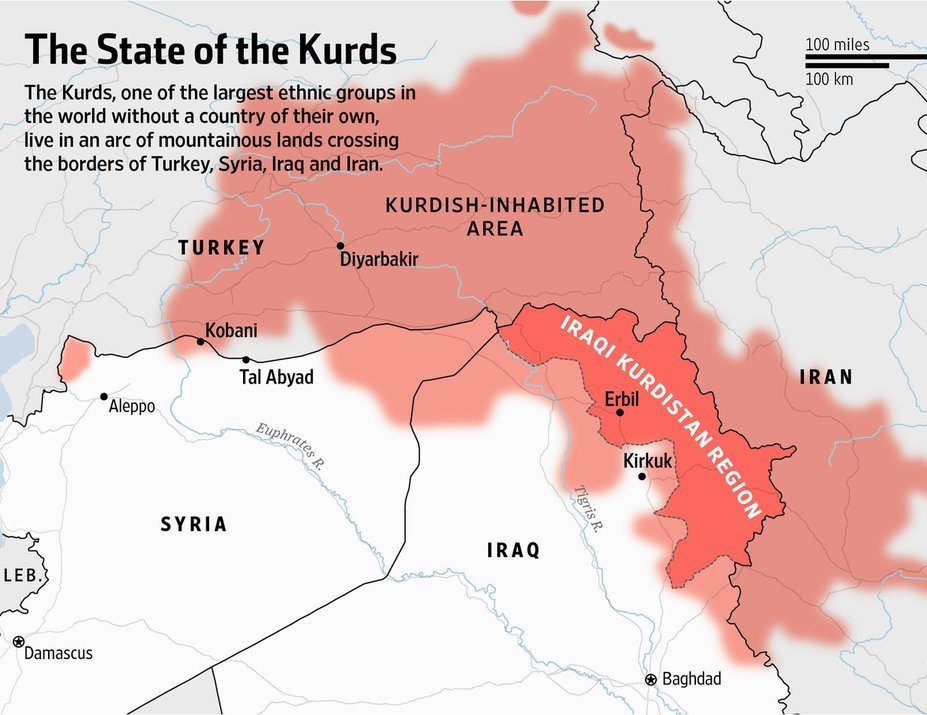
Then at the end of the month, the ISIL leader Abu Bakr al-Baghdadi was supposedly killed by US forces. The alleged location of his last hideout is in Idlib, an area that is under the control of other, supposedly rivaling radical Islamic factions. Why did they harbor him? Did they rat him out? Did they let him in, because the other “al Qaeda”-like faction trying a reunification? How much of the story is made up? Quite some parallels between this event and the mysterious death of Osama bin Laden are noticeable. OBL was allegedly buried at sea., was killed about a year before the US president was trying for reelection. No photos of the successfully killed target person were shown to the public so far. Baghdadi and OBL further share a history of multiple previously reported deaths. The multiple death reports are a common pattern for Jihadist boogiemen, some others are “Abu Musab al-Zarqawi” and “Abu Omar al-Baghdadi”. Would it matter if the stories are made up? From general reasoning it follows that the US intelligence is certain that target person is now not alive. The announcement was pompous and the shame would be great if he would “return”. The location of the raid-site is at about 36.1657586 north 36.6272411,168 east. This is an photo of the site from Twitter user Josie Ensor:
The common most explanation on Twitter and the subreddit for the “circle” is, that a US airstrike was used to cleanse all traces of the raid. The following image is from google maps of that location, taken at an unknown time. What exactly the structure is, where the “circle” can be found later, can not be identified. Not house seemed to have been built there yet. There are no houses at this location on apple maps, and some others. The map on Yandex shows about the same structure as the google map.
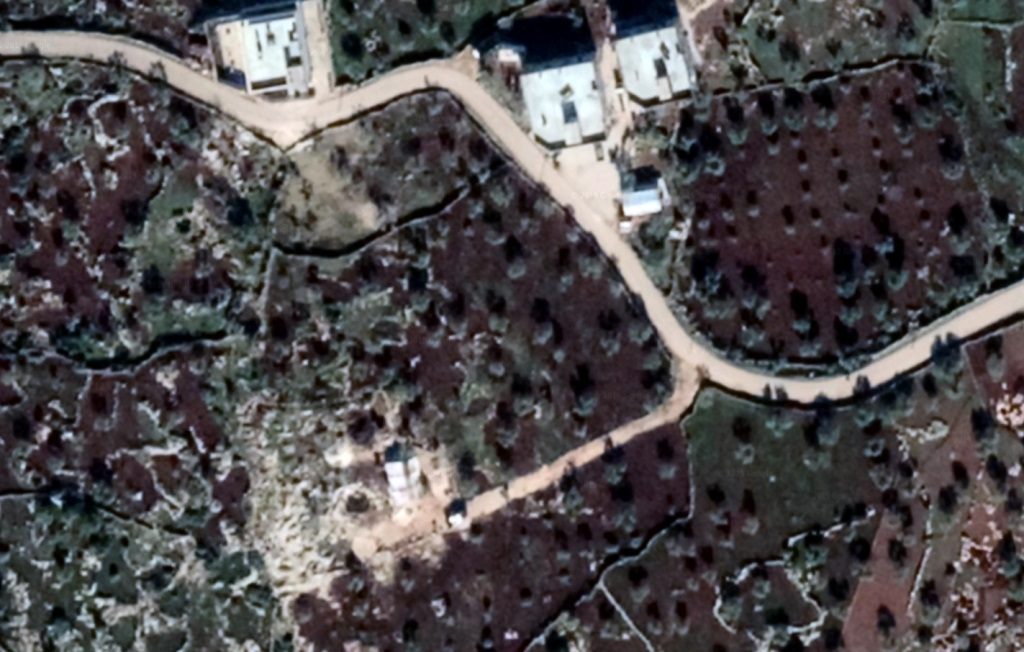
US CENTCOM later released some footage of the attack, that seems to be consistent with the location and the aftermath picture from above.
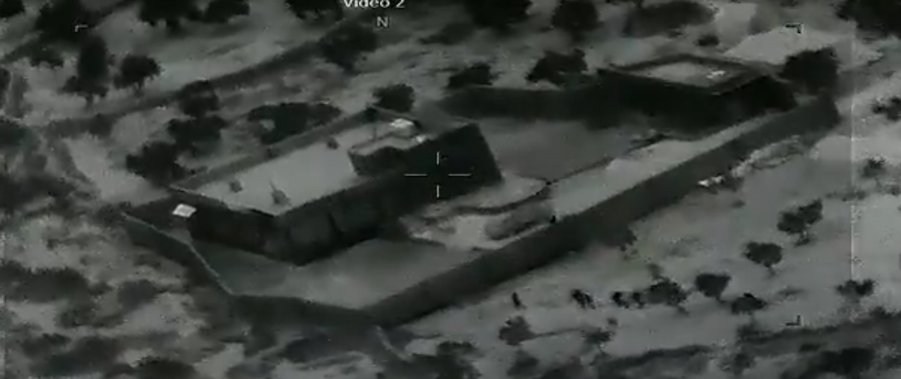
At the end of October the Turkish invasion has come to a halt. Not because it was stopped by force by the YPG, but as a result of multilateral negotiations. The SAA could secure parts of the border and some of the major highways in northeastern Syria. However not all of them – the region directly north of the Eurprates remains under the control of the US. Some US troops have returned to locations that they have left a few weeks earlier.
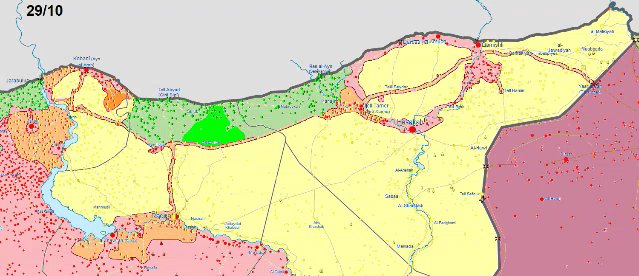
November 2019
So it turned out, the US troops did not only NOT withdraw from Syria, they seem to plan to dig in even deeper. The US released via Twitter pictures of heavy mechanised forces. So far mostly ligher, wheeled vecicles were spotted. Units with tracks need support and cannot easily redepoy by themselves.

In a further plot twist, a closer inspection of what constitutes the “SDF” forcres in the Deir Ezzor region are not Kurdish fighters. The faction cooperating with the US is called “Deir Ezzor military council” and behaves a lot like Islamic fundamentalist. It seems that some ISIS related fighers simply have switched uniforms:
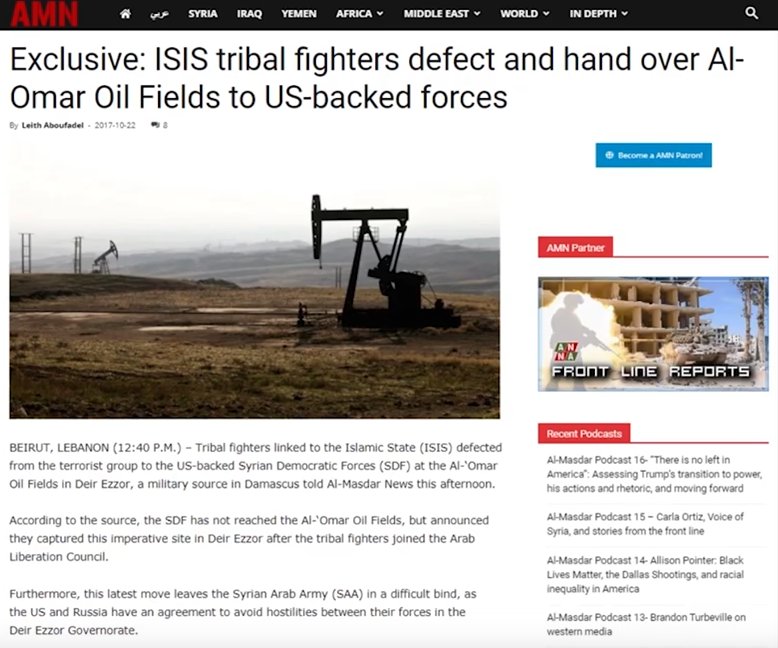
So the US policies have come full circle, from first building up and supporting radical islamist, then fighting them with Kurdish support back to supporting radical islamist, after the plan with the Kurdish break-away state has failed.
Some have suspected that the Tukish invasion could be the last chapter of the SCW, with a reasonable outcome for Assad, Turkey, Russia, Iran and even the US could have at least moved out without having lost face: thesaker.is/revisiting-the-win-win-win-win-outcome-in-syria. However, the conflict is far from over and further turning points are possible…
The real reasons behind the Syrian Civil War
Coming to the end of this article a big reveal of what really drives the SCW would be, in the spirit of good structure, required. But there is no such simple concept. Like with many other complicated social and historical phenomena a mono-causal explanation is unlikely to be correct anyway. Many different and competing interests collide and shape the events. However, some aspects that are NOT the main driving force, if anything a partial, contributing factor are:
It is not a grassroots movement to establish liberal democracy. This view is so ridiculous that it is not even spelled out loud in western media any more, only implied for a section of the viewership how want to believe it… If there was ever any grassroots aspect in the rebellion it was coming from the radical islamic angle.
It is not about oil. It is a popular conception among people how harbor some scepticism towards “official explanations” and have noticed the pattern of hypocritical US foreign policy, that the “middle eastern war on terror” is fought about oil or control thereof. This cannot explain the full story even in the case of Iraq 2003. The cost of the war was so high, the NATO countries could have simply bought Oil for that price. Or employed that money for some sort of belt-and-road-economic-stranglehold strategy.
Syria has little Oil. It also only has a moderately valuable position in respect for Oil and gas transportation. The cost-benefit relation regarding the pipeline disputes alone do not justify the expenses made by some of the conflicting foreign entities:
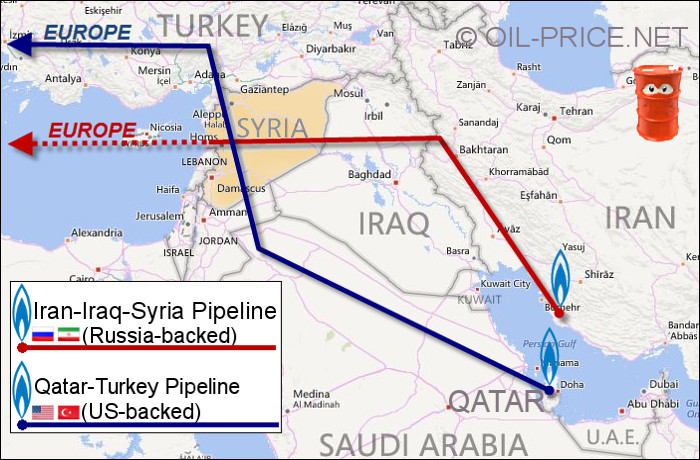
Another thing that is often brought up as a relevant motivation for the war in the context of oil resources is the Genie energy story. It almost looks like a parody of conspiracy theories. Members of the military industrial complex, the Rothschild family, the Rockefeller family and ex CIA bosses get together and enrich themselves with oil from the “Stolan-hights”… But while this is actually true, it is again only a partial contributing factor…

Why then?
The main driving force behind the SCW seems to be, once again, as with many other related developments, the dangerously hot potato: Israel.
To clarify: It probably is not on the mind or in the personal interest of most Israelis or their US-based co-religionists; but only desired by few aggressive, psychopathic, but powerful people – often denoted as “neocons” – to instigate wars between and inside Israel’s neighbors. Initially I mentioned “Yinon plan”, the “A Clean Break” and “Rebuilding America’s Defenses”. Add to that the statement about “Seven countries in five years”, by US General Wesley Clark.
The super-short tl/dr behind that interpretation goes like this: Divide and conquer. If Israel’s enemies are fighting each other, it it save and can even be expanded. Also, the Israel lobby is the most powerful foreign-interest group shaping US politics.
A summaries of Israeli interests is given in a short video called “ISIS Exposed”. Despite its brevity and the openness of the contained information it is so severely damaging to the orthodox narrative about ISIL, The video continues to be aggressively censored. Download it here: “ISIS Exposed”. A more thorough version is given in the movie “Syria Israel’s invisible Hand”: www.ancreport.com/documentary/syria-israels-invisible-hand…

